|
|
|
Jeux
Sans Frontières 1977
European International Series
Entrants
1977:
Belgium (B) • Switzerland (CH) • West Germany (D) •
France (F) • Great Britain (GB) • Italy (I) • Netherlands (NL)
Presenters / Commentators of International Competitions:
Ann Michel and Mike Vendrengh (B)
Ezio Guidi, Jacques Huwyer and Georges Kleinmann (CH)
Manfred Erdenberger and Erhard Keller (D)
Simone Garnier and Guy Lux (F)
Stuart Hall and Eddie Waring (GB)
Giulio Marchetti and Rosanna Vaudetti (I)
Barend Barendse and Dick Passchier (NL)
Fialho Gouveia (RTP - P)
International
Referees:
Gennaro Olivieri
Guido Pancaldi
National Referees:
Arthur Ellis
(Heat 5)
and Mike Swann (GB)
Production Credits:
National Games Designers: Stuart Furber (GB);
National Producers: Cecil Korer (GB); National Directors: Geoff Wilson
(GB)
Produced by the European Broadcasting Union and
RTBF-BRT (B), SSR-SRG-TSI (CH), ARD-WDR (D),
ANTENNE 2 (F), BBC Manchester (GB), RAI (I), NCRV (NL)
|
Key:
International Heats
●
= Qualified for International Final /
●
= Heat Winner (Silver Trophy)
International Final
●
=
Gold Trophy /
●
=
Silver Trophy /
●
=
Bronze Trophy Trophy
▲ = Promoted to Position / ▼ =
Demoted to Position
DST = Daylight Saving Time
(ONLY Belgium, France, Great Britain, Italy and Netherlands observed DST) |
|
|
I |
Jeux
Sans Frontières 1977 |
Heat 1 |
|
Event Staged: Wednesday 1st June 1977
Venue:
Marina di Carrara, Italy
European Transmissions (Local Timings):
SSR (CH): Wednesday 1st June 1977, 8.05-9.25pm (Live)
BRT (B): Wednesday 1st June 1977, 9.05-10.25pm (Live -
DST)
RTBF (B): Wednesday 1st June 1977, 9.05-10.40pm (Live - DST)
TSI (CH): Wednesday 1st June 1977, 9.05-10.25pm (Live - DST)
SRG (CH): Wednesday 1st June 1977, 9.05-10.25pm (Live - DST)
RAI Due (I): Wednesday 1st June 1977, 9.05-10.25pm (Live - DST)
WDR 1 (D): Wednesday 1st June 1977, 10.05-11.30pm
RTP (P): Thursday 9th June 1977,
9.50-10.45pm
Nederland 1 (NL): Friday 10th June 1977, 8.00-9.35pm
Antenne 2 (F): Sunday 31st July 1977
BBC1 (GB exc. Wales): Wednesday 14th September 1977,
6.50-8.05pm
BBC1 Wales (CYM): Sunday 18th September 1977, 1.55-3.10pm |
|
Theme:
Pupazzi degli Dei (Puppets of the Gods)
| |
|
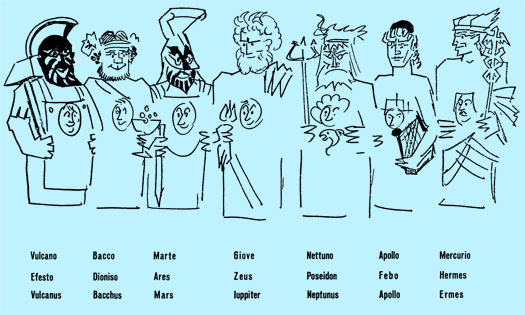 |
|
Image © RAI, 1977 |
| |
|
|
Teams:
Alken (B) v. Freienbach (CH) v. Schliersee (D) v. Ambarès (F) v.
Beverley (GB) v. Marina di Carrara (I) v. Dalfsen (NL) |
|
Team Members
included:
Beverley - Dave Gibson (Team Captain), Debra Windass;
Marina di Carrara (I) - Massimo Bedini (Team Captain), Giorgio Andrei, Patrizio Arata, Graziana
Arcolini, Patrizia Baccioli, Pietro Baruzzo, Elisabetta Buracchioli, Alessandro Lambruschi, Luca Leati, Stefano Menconi,
Cleta Montefiore, Silvano Santucci, Massimo Tedeschi |
|
Games
(Official Titles): Amore (Love), Ganimede... et il Nettare degli Dei
(Ganymede... and the Nectar of the Gods), I Travestimenti di Giove (The
Disguises of Jupiter), Venere, Paride et il Pomo della Discordia (Venus, Paris
and the Apple of Discord), The 12 Fatiche di Ercole (The 12 Labours of
Hercules), Prometeo ci Reprova (Prometheus Tries Again), Pigmalione
(Pygmalion) and Teseo ed Arianna ci Mandano gli dei ne il Labirinto de Cnosso
(Theseus and Ariadne Send the Gods to the Labyrinth of Knossos);
Fil Rouge: Il Mito di Helios (The Myth of Helios);
Reserve Game: Gli Avversari del Sole (The Opponents of the Sun)
(unused). |
|
Game
Results and Standings |
|
Games |
|
Team /
Colour |
1 |
2 |
3 |
4 |
5 |
6 |
7 |
FR |
8 |
Points Scored
(Joker games shown in red) |
|
B |
4 |
--- |
3 |
1 |
4 |
10 |
2 |
3 |
3 |
|
CH |
5 |
3 |
--- |
3 |
4 |
2 |
3 |
6 |
4 |
|
D |
2 |
12 |
6 |
--- |
5 |
4 |
1 |
2 |
6 |
|
F |
1 |
1 |
1 |
5 |
--- |
2 |
4 |
4 |
1 |
|
GB |
3 |
5 |
5 |
2 |
2 |
--- |
6 |
1 |
5 |
|
I |
6 |
5 |
1 |
6 |
12 |
6 |
--- |
7 |
7 |
|
NL |
--- |
2 |
4 |
4 |
8 |
1 |
5 |
5 |
2 |
Running Totals
(Leading teams shown in red) |
|
B |
4 |
4 |
7 |
8 |
12 |
22 |
24 |
27 |
30 |
|
CH |
5 |
8 |
8 |
11 |
15 |
17 |
20 |
26 |
30 |
|
D |
2 |
14 |
20 |
20 |
25 |
29 |
30 |
32 |
38 |
|
F |
1 |
2 |
3 |
8 |
8 |
10 |
14 |
18 |
19 |
|
GB |
3 |
8 |
13 |
15 |
17 |
17 |
23 |
24 |
29 |
|
I |
6 |
11 |
12 |
18 |
30 |
36 |
36 |
43 |
50 |
|
NL |
0 |
2 |
6 |
10 |
18 |
19 |
24 |
29 |
31 |
|
|
|
Result |
Team |
Points |
Final Scoreboard |
|
1st
2nd
3rd
=4th
=4th
6th
7th |
I
• Marina di Carrara
● ●
D • Schliersee ●
NL • Dalfsen
B • Alken
CH • Freienbach
GB • Beverley
F • Ambarès |
50
38
31
30
30
29
19 |
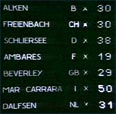 |
|
The Games in Detail |
|
Game 1 - Amore (Love)
| |
|
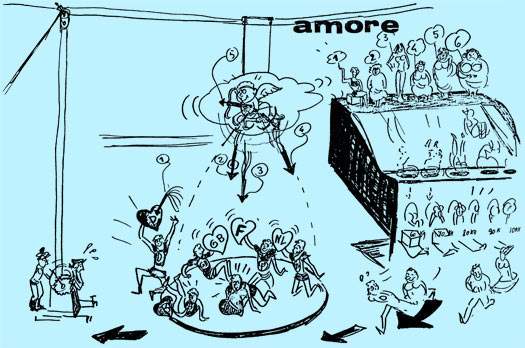 |
|
Image © RAI, 1977 |
| |
|
Running Scores and Positions:
1st Marina di Carrara (I) (6pts awarded / 6pts
total)
2nd Freienbach (CH) (5pts / 5pts)
3rd Alken (B) (4pts / 4pts)
4th Beverley (GB) (3pts / 3pts)
5th Schliersee (D) (2pts / 2pts)
6th Ambarès (F) (1pt / 1pt)
7th Dalfsen (NL) (--- / 0pts) |
Game 2 - Ganimede... et il Nettare degli Dei
(Ganymede... and the Nectar of the Gods)
| |
|
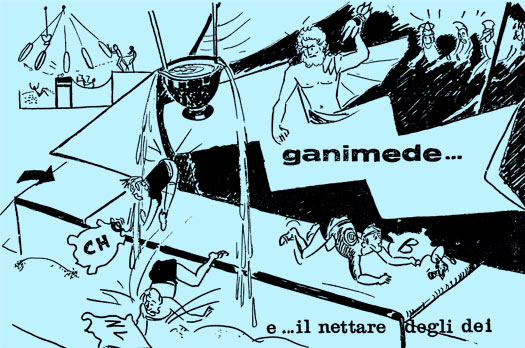 |
|
Image © RAI, 1977 |
| |
|
Running Scores and Positions:
1st Schliersee (D) (12pts awarded / Joker /
14pts total) ▲
2nd Marina di Carrara (I) (5pts / 11pts) ▼
=3rd Freienbach (CH) (3pts / 8pts) ▼
=3rd Beverley (GB) (5pts / 8pts) ▲
5th Alken (B) (--- / 4pts) ▼
=6th Ambarès (F) (1pt / 2pts)
=6th Dalfsen (NL) (2pts / 2pts) ▲ |
Game 3 - I Travestimenti di Giove (The Disguises of Jupiter)
| |
|
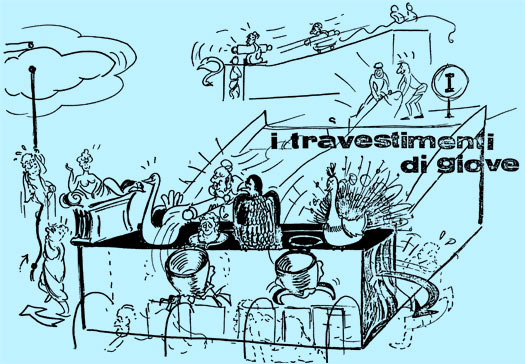 |
|
Image © RAI, 1977 |
| |
|
Running Scores and Positions:
1st Schliersee (D) (6pts awarded / 20pts
total)
2nd Beverley (GB) (5pts / 13pts) ▲
3rd Marina di Carrara (I) (1pt / 12pts) ▼
4th Freienbach (CH) (--- / 8pts) ▼
5th Alken (B) (3pts / 7pts)
6th Dalfsen (NL) (4pts / 6pts)
7th Ambarès (F) (1pt / 3pts) ▼ |
Game 4 - Venere, Paride et il Pomo della Discordia
(Venus, Paris and the Apple of Discord)
| |
|
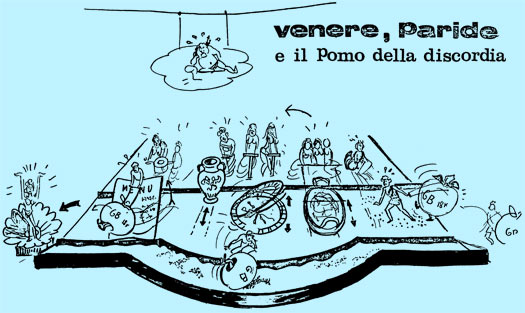 |
|
Image © RAI, 1977 |
| |
|
Running Scores and Positions:
1st Schliersee (D) (--- awarded / 20pts
total)
2nd Marina di Carrara (I) (6pts / 18pts) ▲
3rd Beverley (GB) (2pts / 15pts) ▼
4th Freienbach (CH) (3pts / 11pts)
5th Dalfsen (NL) (4pts / 10pts) ▲
=6th Alken (B) (1pt / 8pts) ▼
=6th Ambarès (F) (5pts / 8pts) ▲ |
Game 5 - The 12 Fatiche di Ercole (The 12 Labours of Hercules)
| |
|
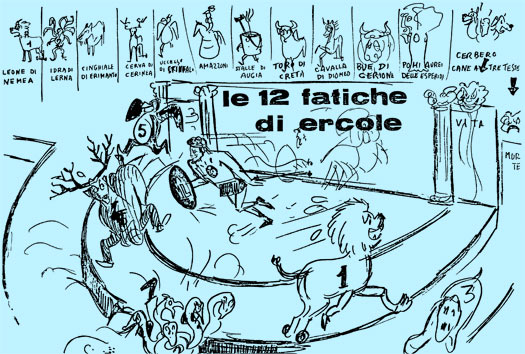 |
|
Image © RAI, 1977 |
| |
|
Running Scores and Positions:
1st Marina di Carrara (I) (12pts awarded /
Joker / 30pts total) ▲
2nd Schliersee (D) (5pts / 25pts) ▼
3rd Dalfsen (NL) (8pts / Joker / 18pts) ▲
4th Beverley (GB) (2pts / Joker / 17pts) ▼
5th Freienbach (CH) (4pts / 15pts) ▼
6th Alken (B) (4pts / 12pts)
7th Ambarès (F) (--- / 8pts) ▼ |
Game 6 - Prometeo ci Reprova (Prometheus Tries Again)
| |
|
 |
|
Image © RAI, 1977 |
| |
|
Running Scores and Positions:
1st Marina di Carrara (I) (6pts awarded /
36pts total)
2nd Schliersee (D) (4pts / 29pts)
3rd Alken (B) (10pts / Joker / 22pts) ▲
4th Dalfsen (NL) (1pt / 19pts) ▼
=5th Freienbach (CH) (2pts / 17pts)
=5th Beverley (GB) (--- / 17pts) ▼
7th Ambarès (F) (2pts / Joker / 10pts) |
Game 7 - Pigmalione (Pygmalion)
| |
|
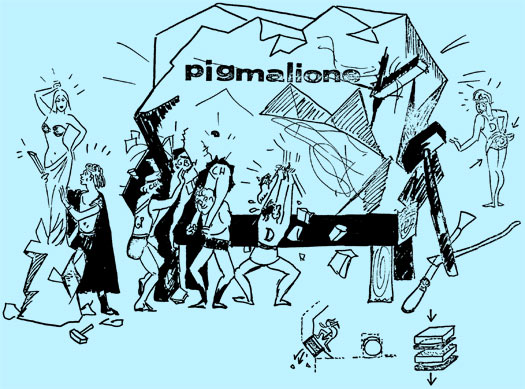 |
|
Image © RAI, 1977 |
| |
|
Running Scores and Positions:
1st Marina di Carrara (I) (--- awarded /
36pts total)
2nd Schliersee (D) (1pt / 30pts)
=3rd Alken (B) (2pts / 24pts)
=3rd Dalfsen (NL) (5pts / 24pts) ▲
5th Beverley (GB) (6pts / 23pts) ▲
6th Freienbach (CH) (3pts / 20pts) ▼
7th Ambarès (F) (4pts / 14pts) |
Fil Rouge - Il Mito di Helios (The Myth of Helios)
| |
|
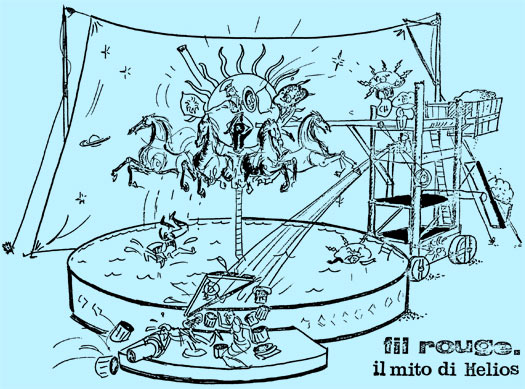 |
|
Image © RAI, 1977 |
| |
|
Final Fil Rouge Standings:
1st Marina di Carrara (I)
2nd Freienbach (CH)
3rd Dalfsen (NL)
4th Ambarès (F)
5th Alken (B)
6th Schliersee (D)
7th Beverley (GB) |
|
Running Scores and Positions:
1st Marina di Carrara (I) (7pts awarded /
43pts total)
2nd Schliersee (D) (2pts / 32pts)
3rd Dalfsen (NL) (5pts / 29pts)
4th Alken (B) (3pts / 27pts) ▼
5th Freienbach (CH) (6pts / 26pts) ▲
6th Beverley (GB) (1pt / 24pts) ▼
7th Ambarès (F) (4pts / 18pts) |
Game 8 - Teseo ed Arianna ci Mandano gli dei ne il Labirinto de Cnosso
(Theseus and Ariadne Send the Gods to the Labyrinth of Knossos)
| |
|
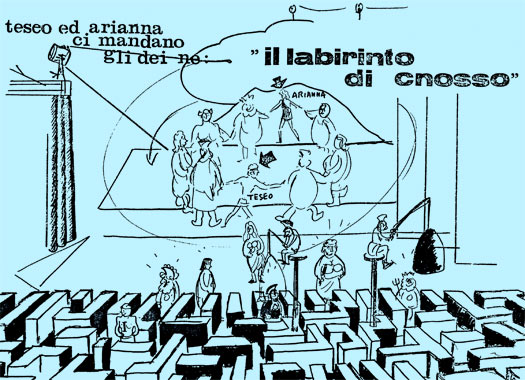 |
|
Image © RAI, 1977 |
| |
|
Final Scores and Positions:
1st Marina di Carrara (I) (7pts awarded /
50pts total)
2nd Schliersee (D) (6pts / 38pts)
3rd Dalfsen (NL) (2pts / 31pts)
=4th Alken (B) (3pts / 30pts)
=4th Freienbach (CH) (4pts / 30pts) ▲
6th Beverley (GB) (5pts / 29pts)
7th Ambarès (F) (1pt / 19pts) |
Reserve Game: Gli Avversari del Sole (The Opponents of the Sun)
An elaborate reserve game - 'Gli Avversari del Sole (The
Opponents of the Sun)' - was prepared for the night in case of technical or
mechanical failures rendering other games void. As the producers hoped, such
disasters did not come to pass and hence this reserve game was not called into
service. It is possible to imagine what it might have been like from its title
and Adolfo 'Popi' Perani's cartoon illustration.
| |
|
 |
|
Image © RAI, 1977 |
| |
|
|
Presenters, Officials and Production Team |
|
Italian games designer Adolfo 'Popi' Perani once again produced a spectacular heat.
With the theme of Greek Mythology, one of the games was based around 'The
Twelve Labours of Hercules’. The game involved one male member of each team
trying to knock over each of the twelve ‘labours’ - two opposing members from
each side and two from his own team - so a score of at least two was
guaranteed. These ‘labours’ included the Nemean Lion, the Hydra of Lemae, the
Augean Stables, the Stymphalian Birds, the Cretean Bull, the Apples of
Hesperides and Cerberus the guardian dog of Hades. All wonderfully costumed,
it was one of those games that caused the BBC commentator, Stuart Hall, to
descend into in fits of laughter. |
|
Additional Information |
|
French broadcaster Antenne 2 played around with the schedule
for the first three heats, starting with Heat 3 and then following with 1 and
2. They had intended to start with Heat 2, their home heat - and indeed Guy
Lux made a point of welcoming viewers and the live audience to the first event
of Jeux Sans Frontières 1977 in his opening announcement at the Évry
heat. However, plans quickly changed as Antenne 2 wanted to start the series
with a strong French performance, something that neither Heat 1 or 2 provided
(Ambarès 7th in Heat 1 and Évry 5th in Heat 2). Heat 3 saw a 4th place finish
for Blanzac-Porcheresse and that heat was duly promoted to first in sequence. Quite why
they didn't head the schedule with Fontainebleau's victory in Heat 4, which
was available at the time of the first Antenne 2 transmission of 1977, is open
to conjecture. |
|
Made
in Colour • This programme exists in the BBC Archives |
|
|
|
F |
Jeux
Sans Frontières 1977 |
Heat 2 |
|
Event Staged: Wednesday 15th June 1977
Venue:
Parc du Safari de Saint-Vrain, Évry, France
European Transmissions (Local Timings):
SSR (CH): Wednesday 15th June 1977, 8.05-9.25pm (Live)
TSI (CH): Wednesday 15th June 1977, 9.00-10.20pm
SRG (CH): Wednesday 15th June 1977, 9.05-10.25pm
BRT (B): Wednesday 15th June 1977, 9.05-10.25pm (Live - DST)
RTBF (B): Wednesday 15th June 1977, 9.05-10.25pm (Live - DST)
RAI Due (I): Wednesday 15th June 1977, 9.05-10.25pm (Live - DST)
Nederland 1 (NL): Wednesday 15th June 1977, 9.00-10.30pm (Live - DST)
WDR 1 (D): Wednesday 15th June 1977, 10.05-11.30pm
RTP (P): Thursday 23rd June 1977,
9.35-10.40pm
Antenne 2 (F): Sunday 7th August 1977
BBC1 (GB exc. Wales): Wednesday 21st September 1977,
6.50-8.05pm
BBC1 Wales (CYM): Sunday 25th September 1977, 1.55-3.10pm |
|
Theme:
Science Fiction and Horror Films |
|
Teams:
Frameries (B) v. Olivone (CH) v. Dahn (D) v. Évry (F) v.
Oldham (GB) v. Solofra (I) v. Buren (Betuwe) (NL) |
|
Team Members
included:
Olivone (CH) - Dino Solari (Men's Team Captain),
Barbara Cima (Women's Team Captain), Ortensio Bassi, Lauro Beffa, Edy Beretta, Ortensia Genucchi,
Vincenzo Giuliani, Rolande Hirter, Renzo Jacomett, Lucia Poglia, Loris Solari,
Fernando Vini, Renzo Zanetti, Roberto Zanetti;
Évry (F) - Michelle Villeau;
Oldham (GB) - Derek Smallwood (Team Manager), Dorothy
Emerson (Women's Team Manager), Tom
Hill (Assistant Team Coach), Diane Cook (Assistant Team Coach), Stephen Andrews,
Sheila Antrobus, Lynne Bowden, Johnathon Boyce,
Michael Cannon, Frank Collinson, Carol Driver, Nadia Duda, Tony Edwards, Don
Errock, Eric Fitzsimmons, Barry Gordon, Karen Halliwell, Ian Hamilton, Warren
Hilton, Syd Jolley, Steve Kenney, Alex Kerrigan, Ruth Lawson, Michael Maloney,
Nicholas Marrington, Mark McLoughlin, Tony Nanyn,
Fiona Nicholl, Brian Parkinson, Christine Silk, Bob Tait, Alison Turner, Jane
Welton;
Solofra (I) - Rita Dembastro. |
|
Games:
Barbarella, Dr. Jekyll and Mr. Hyde, Frankenstein’s Monster, Phantom of the
Opera, Moby Dick, Dracula, Superman and
Godzilla;
Fil Rouge: King Kong.
Jokers: Bananas. |
|
Game
Results and Standings |
|
Games |
|
Team /
Colour |
1 |
2 |
3 |
4 |
5 |
6 |
7 |
FR |
8 |
Points Scored
(Joker games shown in red) |
|
B |
2 |
4 |
6 |
--- |
3 |
6 |
4 |
3 |
7 |
|
CH |
3 |
5 |
4 |
3 |
--- |
3 |
12 |
5 |
5 |
|
D |
3 |
6 |
1 |
6 |
8 |
--- |
2 |
1 |
6 |
|
F |
1 |
1 |
2 |
2 |
5 |
12 |
--- |
6 |
4 |
|
GB |
--- |
1 |
3 |
6 |
6 |
4 |
10 |
4 |
3 |
|
I |
5 |
--- |
6 |
8 |
3 |
5 |
3 |
1 |
1 |
|
NL |
6 |
3 |
--- |
4 |
1 |
3 |
1 |
7 |
2 |
Running Totals
(Leading teams shown in red) |
|
B |
2 |
6 |
12 |
12 |
15 |
21 |
25 |
28 |
35 |
|
CH |
3 |
8 |
12 |
15 |
15 |
18 |
30 |
35 |
40 |
|
D |
4 |
10 |
11 |
17 |
25 |
25 |
27 |
28 |
34 |
|
F |
1 |
2 |
4 |
6 |
11 |
23 |
23 |
29 |
33 |
|
GB |
0 |
1 |
4 |
10 |
16 |
20 |
30 |
34 |
37 |
|
I |
5 |
5 |
11 |
19 |
22 |
27 |
30 |
31 |
32 |
|
NL |
6 |
9 |
9 |
13 |
14 |
17 |
18 |
25 |
27 |
|
|
|
Result |
Team |
Points |
Final Scoreboard |
|
1st
2nd
3rd
4th
5th
6th
7th |
CH
• Olivone
● ●
GB • Oldham ●
B • Frameries
D • Dahn
F • Évry
I • Solofra
NL • Buren (Betuwe) |
40
37
35
34
33
32
27 |
 |
|
The Host Town |
|
Évry, France
Évry, located in the southern suburbs of Paris, is classified as a ‘new
town’ and was created in the 1960s. It lies 26km (16 miles) south of the city
centre, 73km (45¼ miles) east of Chartres and 31km (19¼ miles) north-west of
Fontainebleau. Évry is demographically the second youngest town in France with
the average age of the population being only 26 years old (recently being
beaten by Mulhouse with an average age of 24 years).
In 1881, the name of the commune, originally called Évry-sur-Seine, was
changed to Évry-Petit-Bourg at the request of entrepreneur Paul Decauville
(1846-1922), owner of Ateliers de Petit-Bourg, a large boiler works located in
Évry and at the time the largest employer in the area. The factory owed its
name to the hamlet of Petit-Bourg (one of the three hamlets on the territory
of Évry) where it was built. On 29th June 1965, after it had been chosen to
become a ‘new town’, its name was shortened to Évry, and was destined to host
tens of thousands of suburbanites from the overflowing Paris. The name
Petit-Bourg (literally meaning little borough or small town) was deemed too
old fashioned and improper for the new large suburban town of Évry.
The Cathedral of the Resurrection, dedicated to Saint Corbinien, was designed
by Swiss architect Mario Botta and is one of the few 20th century cathedrals
built in a truly modern style. It was completed in 1995 and is 34m (111ft
6½in) high and comprises 840,000 handmade red bricks crowned by a ring of
trees around the edge of the roof. It had a total cost of €13.72 million
(£10.93 million) and covers a total surface of 1,600m² (17,222ft²) and can
accommodate up to 1,400 people. Pope John-Paul II (Karol Józef Wojtyła)
(1920-2005) made a visit on 22nd August 1997, and although car parks were
requisitioned as far away as Corbeil-Essonnes, fewer than 500 people turned
out for the event. This has resulted in Évry holding the unwanted world record
for the smallest crowd at a papal appearance. Some people consider the modern
cathedral as an architectural beauty while others liken the design to that of
a blast furnace.
The Pagoda Khan-Anh, covering an area of 3,287m² (35,381ft²) is the largest
pagoda in Europe and accommodates 1,500 people. The initial cost was estimated
at €7.6 million (£6.57 million) but was expected to have doubled by the end of
its construction. Work began in 1996 and was finally completed in 2012. The
statue of Buddha, 4m (13ft 1½in) tall and weighing 4,535kg (5 tons), arrived
from Thailand on 20th October 2002.
Although Évry is a modern ‘new town’, which is generally synonymous with being
a ‘concrete jungle’, 50% of its surface area is parkland and open space. The
main thoroughfares are very wide avenues and trees are to be found everywhere.
In the nationwide inter-communal competition Ville Fleurie (floral town), Évry
has been awarded the high status of ‘three flowers’, usually only won by
country villages. To encourage this aspect of the town an annual Balcon Fleuri
(floral balcony) competition is held. A similar balcony competition is held
each December for the best exterior Christmas decorations.
When Évry was built, Orly was the largest international airport of France and
many international companies such as Digital, Hewlett Packard, and Alsthom
established their head offices in Évry. However, with the expansion of Charles
de Gaulle Roissy airport, all the larger companies have moved out causing the
downfall of the many smaller service companies which catered to the lunchtime
needs of the thousands of staff which were either displaced or made redundant.
Amongst the few international companies remaining is the supermarket chain of
Carrefour.
|
|
The Venue |
|
Parc du Safari de Saint-Vrain
The games were played in the grounds of the Saint-Vrain Safari Park which was
located within the grounds of the medieval Château of Saint-Vrain.
Originally owned by Jeanne Bécu de Cantigny (1743-1793), the Countess du Barry
between 1774 and 1776, the château came into the ownership of Jacques
Alexandre Gourlade (1735-1803), an owner at the port of Lorient and who had
held several positions within the French East India Company. It then became
subject of a reconstruction in the 19th century after which it moved into the
ownership of the Mortemart family and remains in private ownership today.
Towards the end of the 1960s, Charles-René de Mortemart
(1929-1984) decided to transform the exotic landscape park into a safari park,
with its design modelled on Woburn Safari Park located at Woburn Abbey in
Bedfordshire.
Construction of the 140 hectare site began in early 1971 and
required considerable work to create artificial ponds connected by a system of
channels for it to become one of the most visited sites in Île-de-France. It
offered an area which could be traversed by car over a 9km (5½ miles) drive
with more than a thousand animals on view roaming in semi-freedom. The park,
which included a menagerie of monkeys, elephants, large mammals, sea lions and
giraffes, was officially opened to the public on 14th March 1974.
The park continued to develop even after the public opening and
before the tourist summer season began, it integrated several big cats. At the
same time, a floating aviary was established on the lake, the first of its
kind in the world. To ensure that visitors could enjoy this and other bestial
attractions, a boat safari was established.
In 1981, a funfair was installed in the grounds with automaton
theatres which told the story of the chateau, the rich Borghese and Mortemart
families in the early 19th century and the fables of Jean de La Fontaine
(1621-1695). However, following a misunderstanding and disagreements with the
park’s owner between 1982 and 1984, the funfair decamped at the end of 1984.
To replace the funfair, the park opened a section dedicated to
prehistoric times for the 1985 season, where animated dinosaurs and humans
were exhibited. The whole area was supplemented by information boards and
sound systems were installed to recreate the sounds of the giant beasts. This
all resulted in visitors being able to admire the first reconstructions of
prehistoric animals in natural size and, with the participation of the Musée
de l'Homme (Museum of Man), a chronology of the evolution of mankind. To
coincide with this, a prehistoric boat safari (independent of the boat safari)
was introduced which navigated the small rivers in the middle of prehistoric
park and would take approximately 30 minutes.
In 1986, a high monorail circuit was constructed which enabled
visitors to traverse the whole park in just 18 minutes for 45 Francs (approx
£4.15). The park continued to have great success throughout the 1980s, but
despite enjoying more than 600,000 visitors a year it continually found itself
in competition with the Parc Zoologique de Thoiry (Zoological Park at Thoiry),
located 53km to the north-west.
During 1996, an unknown epidemic decimated a lot of animals and
following animal rights campaigns, it was decided to turn the grounds into a
floral park with a small zoo. Ironically, this had been the original wish of
the first owner. In 1998, thousands of plants were planted and the surviving
animals moved into small prefabricated enclosures. However, with heavy rain
throughout the autumn of that year, and not to mention the fact that the zoo
was built on marshy ground, the area became flooded. Visitor numbers, already
being reduced drastically due to the lack of animals, dwindled further. The
saturated ground claimed most of the bulbs which had been planted and, having
invested so much money in the project, the owner decided to close the park at
the end of 1998. Today, although the château still remains, the safari park
site lies abandoned with only the outlines of the enclosure and public
entrance visible from the air.
|
|
The Games in Detail |
|
Game 3 - Frankenstein's Monster
Game 3 was based on the horror film Frankenstein, and
involved a girl (again with tied ankles) having to negotiate a winding course,
planting giant flowers into vases with very small mouths. After ten seconds
start, the girl's pusuer was released and out from behind closed doors
appeared Frankenstein's monster, an 8ft giant with huge square boots (which
hindered the movement of the opposing team member inside). The monster had to
catch the girl by ‘tagging’ her. Not surprisingly, each of the six heats of
this game did not last very long and none lasted more than thirty seconds.
Game 5 - Moby Dick
Oldham team member Fiona Nicholl played a blinder on Game 5,
based on the film Moby Dick, in which she was dressed as a mermaid and had
to jump around a carousel-shaped course with her ankles tied together, chased
by a 15ft open-mouthed whale, which was operated by two opposing team members.
The five other competing girls could only manage to keep going for about 10-33
seconds before being engulfed by the whale, but Fiona kept going and was
finally caught after 92 seconds, surviving 59 seconds longer than her nearest
rival. She was delighted (and somewhat fatigued) to win six
points for the team.
Game 6 - Dracula
At the start of Game 6 - ‘Dracula’ - a loose King Charles spaniel
ran into the arena and across the game set. Astonished scene hands desperately
tried to catch the loose animal, but to no avail. However, eventually it ran
back into the crowd as fast as it had appeared! |
|
Presenters, Officials and Production Team |
|
It just goes to show that you cannot believe everything that your
own national commentator tells you. At the start of Game 5, BBC commentator
Stuart Hall clearly stated that the game was based on the film Jaws and then
went on to describe the film in his florid style, but the props did
not fit in with his description of the game’s theme. However in the A2
(France) transmission, presenter Guy Lux stated that the game is based on the
film Moby Dick, which clearly fitted in with the game’s theme! |
|
Additional Information |
|
This French heat
was originally to have been held in Lyon, as evidenced by a promotional
sticker produced by the Frameries team which denoted Lyon as the venue.
Following on from the Italian heat, came a very well costumed French
heat. Games were based on famous science fiction and horror films, and
included games based on Dr Jekyll and Mr Hyde, Dracula and
Godzilla.
The Fil Rouge
that featured in this International Heat consisted of a male competitor in a gorilla outfit negotiating an obstacle
course. In his hand, he was carrying a banana which had to be delivered into the hand of a
forty-foot high, three ton King Kong figure. The construction had mechanical
grab mechanisms in its arms which were strong enough to support two people
standing in the creature's left hand. It could also be made to roar.
It would appear that after its construction for the Évry
JSF programme, the giant gorilla prop - unfortunately rechristened Big
Mong - was sold to the French Carrefour hypermarket
chain, who used it for publicity purposes. As a result, this jaw-dropping creation later made an unexpected appearance at the
sixth anniversary celebrations of Carrefour's hypermarket in Caerphilly, South Wales, in 1978.
One wonders just how awkward it was to transport from France to Great
Britain!
BBC Wales
reporter, Jennifer Murray contributed a short report to Wales Today. No
mention was made of Jeux Sans Frontières, just that the giant-sized
prop had been built by French engineers. At
the end of the report she did a 'Fay Wray' by being hoisted up in its giant
hand! The courageous lady pictured here with the jungle beast is
beauty queen Cheryl Perry of Bargoed, then the reigning Miss Caerphilly.
Perhaps unsurprisingly, the erection of the politically
correctly named giant outside the Carrefour attracted the interest of
local councillors including one Howard Edwards who complained to the local
press that "I realise this monstrosity will have a lot of appeal for
children, but I believe planning permission is needed to put it up. Big
Mong is 40ft high and can be seen from a wide area of the town. The roar
of the gorilla can be quite startling to someone with a nervous
disposition." Mr Edwards' concerns came to nought and the prop stood
outside the Carrefour shop for five days.
|
|
Made
in Colour • This programme exists in the BBC Archives
Exists in European archives |
|
|
|
CH |
Jeux
Sans Frontières 1977 |
Heat
3 |
|
Event Staged: Wednesday 29th June 1977
Venue:
Carré du Marche, La Place de Sardaigne, Carouge, Switzerland
European Transmissions (Local Timings):
SSR (CH): Wednesday 29th June 1977, 8.05-9.25pm (Live)
SRG (CH): Wednesday 29th June 1977, 9.00-10.20pm
TSI (CH): Wednesday 29th June 1977, 9.00-10.20pm
RAI Due (I): Wednesday 29th June 1977, 9.05-10.25pm (Live - DST)
Nederland 1 (NL): Wednesday 29th June 1977, 9.00-10.30pm (Live - DST)
BRT (B): Wednesday 29th June 1977, 9.05-10.25pm (Live - DST)
RTBF (B): Wednesday 29th June 1977, 9.05-10.25pm (Live - DST)
WDR 1 (D): Wednesday 29th June 1977, 10.05-11.30pm
RTP (P): Thursday 7th July 1977,
9.50-11.15pm
Antenne 2 (F): Sunday 24th July 1977
BBC1 (GB exc. Wales): Wednesday 28th September 1977,
6.50-8.05pm
BBC1 Wales (CYM): Sunday 2nd October 1977, 1.55-3.10pm |
|
Theme:
Courtship and Marriage Tasks |
|
Teams:
Zwevegem (B) v. Carouge (CH) v. Schwäbisch Gmünd (D) v.
Blanzac-Porcheresse (F) v. Macclesfield (GB) v. Moena (I) v. Nieuwegein (NL) |
|
Games
Demonstration Team: Roche (CH) |
|
Team Members included:
Carouge (CH) - Michel Albert, Daniel Chappuis, Serge Desbiolles,
Pia Hauri, Joëlle Hermann, Marianne Julita, Evelyne Lachat, Roland Mage,
Charles Moret, Divina Pastor, Bernard Poussin, Bertrand Raval, Jacques Rosset,
Didier Zanone;
Blanzac-Porcheresse (F) - Michel Roy (Team Coach), Jean-Marie
Brunelière, Pascal Durand, Jeanine Egreteau;
Macclesfield (GB) - Alec Collins (Team Manager), Steve Midgelow
(Co-Team Coach), Steve Smith (Co-Team Coach), Keith Goalen (Co-Team Coach),
Robbie Brightwell (Team Advisor), Elaine Banner, Ann Birtwistle, Ian Booth,
Richard Collins, Jen Culshaw, Julie Cunningham, Jennifer Goodwin, Alison
Hague, Monica Hanson, Beverley Nolan, Dianne Perrit, Niki Seddon, Shirley
Willdig;
Nieuwegein (NL) - Jaap Ruizeveld (Co-Team Manager), Jaap Verweij (Co-Team
Manager), Lenie Lens-Gerrietsen
(Team Coach), Henk Vonk (Team Captain), Herman Elbertse, Ad Epping, Gerard
Evers, Yvonne Hoefs, Jan van Kippersluis, Ina van der Linden, Maarten Oomen,
Martin Plink, Margot Posthouwer, Lida Raaphorst, Emiel Schaap, Johan van Wijk.
Reserves: Max Bé, Agnes Ritmeester. |
|
Games:
Balloon Bursting, Shoeing the Horses, Smashing Vases, Puppets, Banging the
Hammer, Balloons on Carts, The Ugly Woman and Climbing Up Carpet;
Fil Rouge: Witches in Bed. |
|
Game
Results and Standings |
|
Games |
|
Team /
Colour |
1 |
2 |
3 |
4 |
5 |
6 |
7 |
FR |
8 |
Points Scored
(Joker games shown in red) |
|
B |
4 |
3 |
1 |
2 |
4 |
--- |
6 |
7 |
5 |
|
CH |
5 |
1 |
2 |
1 |
1 |
6 |
--- |
3 |
1 |
|
D |
--- |
4 |
5 |
3 |
5 |
4 |
3 |
5 |
7 |
|
F |
6 |
--- |
3 |
5 |
3 |
5 |
2 |
6 |
2 |
|
GB |
1 |
5 |
--- |
4 |
2 |
2 |
1 |
1 |
3 |
|
I |
3 |
2 |
5 |
--- |
12 |
4 |
4 |
2 |
6 |
|
NL |
10 |
6 |
6 |
6 |
--- |
6 |
5 |
4 |
4 |
Running Totals
(Leading teams shown in red) |
|
B |
4 |
7 |
8 |
10 |
14 |
14 |
20 |
27 |
32 |
|
CH |
5 |
6 |
8 |
9 |
10 |
16 |
16 |
19 |
20 |
|
D |
0 |
4 |
9 |
12 |
17 |
21 |
24 |
29 |
36 |
|
F |
6 |
6 |
9 |
14 |
17 |
22 |
24 |
30 |
32 |
|
GB |
1 |
6 |
6 |
10 |
12 |
14 |
15 |
16 |
19 |
|
I |
3 |
5 |
10 |
10 |
22 |
26 |
30 |
32 |
38 |
|
NL |
10 |
16 |
22 |
28 |
28 |
34 |
39 |
43 |
47 |
|
|
|
Result |
Team |
Points |
Final Scoreboard |
|
1st
2nd
3rd
=4th
=4th
6th
7th |
NL
• Nieuwegein
● ●
I • Moena
D • Schwäbisch Gmünd
F • Blanzac-Porcheresse
B • Zwevegem
CH • Carouge
GB • Macclesfield |
47
38
36
32
32
20
19 |
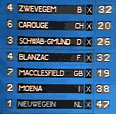 |
|
The Venue |
|
Carouge, Switzerland
The 1977 Swiss heat was originally planned to be held in Vevey at an
amphitheatre that was being built for the 1977
Fêtes des Vingerons (Winegrowers'
Festival). Unfortunately, these plans had to be changed as the construction
work in Vevey was running behind schedule. The SSR then considered two
alternative sites for their 1977 Jeux Sans Frontières heat, these being
La Chaux-de-Fonds and the eventual choice, Carouge. The cost of staging JSF in
Carouge was reported as being 200,000 Swiss francs. |
|
The
Rehearsals |
|
As the competing teams were not allowed to see the games prior
to rehearsals, SSR called in the team from Roche who had won at Milano in 1976
to test the games. This also served as a technical run-through, giving the
director an opportunity to check camera angles and other requirements for the
transmission. |
|
Reunions |
|
Nieuwegein (NL)
The triumphant Dutch team from Nieuwegein held a reunion event
on Saturday 31st October 2009 which was covered by the national media
including RTV9 television news. The team members convened in Nieuwegein's 't
Veerhuis (Ferry House), where they
watched their 1977 exploits on the big screen. Afterwards, team members shared
reminiscences and spoke to reporters. One of the Nieuwegein team members, Jaap Ruizeveld recalled how Nieuwegein
was then a new municipality joining the towns of Jutphaas and Vreeswijk and
that it was the Jeux Sans Frontières entry that really brought these
two towns together: "Everyone accepted and watched, because Nieuwegein was on
TV... Nieuwegein saw it as an enormous festival. All the papers were
represented. It was a gigantic happening at the time. Everybody participated
in it, everybody knew each other and because of that there was a community to
stand behind it. The enthusiasm was incredible - and buses full of people
followed the team on their travels abroad and celebrated their achievements.
For me and my family it was a great thing to do. I was on holiday when it was
held in Carouge. We were in Italy with the family and flew over by plane from
Milan to Carouge, that was possible at that time! It was too crazy to tell."
Jaap Verwey, who in 1977 was Nieuwegein's team co-ordinator,
remembered it as a joyous experience: "Spel zonder Grenzen was very
popular at that time, not just in the Netherlands, but also in the six other
participating countries there was an enormous audience. It was broadcast by
the NCRV and it had an enormous impact. I was in charge of sports in the
municipality, so for something like this, it was down to me. 'That is your
business,' they said. And in those years, it took hours, but it was a pleasure
to do, with so many others participating as well. The youngest one was Maarten
Omen, who was at the marina and was a really happy guy. But sometimes we had
to keep him under control! Another memory is that team members could sometimes
get stressed under pressure, especially when we were getting near to another
contest, but there always was a great, sportive mood! That's also an advantage
from the technical viewpoint of a team like that, because not only do you
select on the sportive mood, but also the personality they have."
Husband and wife Henk
Vonk and Lenie Lens had acted as co-team coaches to the team in 1977. Henk
recalled, "We had to see what games we were expected to compete in, so that we
were well prepared for what we had to do in them. I enjoyed the team spirit
and the training - because I was responsible for the training - and the next
day, the men always had muscle pain everywhere! They thought they could do it
as if they were playing football! And I enjoyed that of course! However,
working with everyone was the best thing."
Lenie enjoyed the training sessions more than anything else:
"We had a gym available at 8.00am and also at 10.00pm and we used those hours
to prepare. When we found out about the games we would be playing, we came
together and said, 'Guys, we're gonna try it!'. It was all very creative, but
my husband Henk would always say, 'I'm going to try it first and then
we're going to do it!'"
All those present agreed that the reunion was a great
idea and a success and that their time on Jeux Sans Frontières was well
worth celebrating.
|
|
Additional Information |
|
Macclesfield went to this heat just a week after being crowned British
Champions, and had strong convictions that they would also win this heat.
During rehearsals, they faired well, but on the night of the recording,
torrential rain brought about a night of disappointment for the team. Their
Joker game - in which the team had to lift a 25-foot hammer 180 degrees on a
pivot - was a complete disaster. Macclesfield won the
game on both occasions in the rehearsals, but on the night they went first, tried too hard and
lifted the hammer out of the pivot. The other five countries seeing this got
their girl member to sit on the hammer at the pivot to counterbalance it.
Macclesfield finished last with just 2 points from their Joker. Two more last
places followed and the team set the record for the lowest score by any
British team in Jeux Sans Frontières. However, Rotherham would
eventually take this unwanted record away from Macclesfield in 1982. |
|
Made
in Colour • This programme exists in the BBC Archives
Exists in European archives |
|
|
|
D |
Jeux
Sans Frontières 1977 |
Heat
4 |
|
Event Staged: Wednesday 13th July 1977
Venue:
Marktplatz, Ludwigsburg, West Germany
European Transmissions (Local Timings):
SSR (CH): Wednesday 13th July 1977, 8.05-9.25pm (Live)
SRG (CH): Wednesday 13th July 1977, 9.00-10.20pm
TSI (CH): Wednesday 13th July 1977, 9.00-10.20pm
Nederland 1 (NL): Wednesday 13th July 1977, 9.00-10.30pm (Live - DST)
BRT (B): Wednesday 13th July 1977, 9.05-10.25pm (Live - DST)
RTBF (B): Wednesday 13th July 1977, 9.05-10.25pm (Live - DST)
RAI Due (I): Wednesday 13th July 1977, 9.05-10.25pm (Live - DST)
WDR 1 (D): Wednesday 13th July 1977, 10.05-11.30pm
RTP (P): Thursday 21st July 1977,
9.40-11.00pm
Antenne 2 (F): Sunday 14th August 1977
BBC1 (GB exc. Wales): Wednesday 5th October 1977,
6.50-8.05pm
BBC1 Wales (CYM): Sunday 9th October 1977, 1.55-3.10pm |
|
Theme:
The Characters of Walt Disney |
|
Teams:
Spa (B) v. Zurzach (CH) v. Ludwigsburg (D) v. Fontainebleau (F) v.
Cwmbran (GB) v. Lagonegro (I) v. Gilze en Rijen (NL) |
|
Team Members included:
Cwmbran - Geoff Whiston (Team Manager / Team Captain), Susan Brimble
(Women's Team Captain), David Ball, Julie Barrett, Alan Chorlton, Peter
Davies, Amanda Ellis, Michael Gould, Jan Jenner, Caron Jones, Paula Middle,
John Price, Philip Ramsey, David Smith, Alan Tinsley, Keith Wells, Alan
Wilmott. |
|
Games:
Pluto, Donald Duck, Mickey Mouse, Goofy, King Louie, The Three Little Pigs,
Baloo and Mowgli and Snow White and the Seven Dwarfs;
Fil Rouge: The Vultures. |
|
Game
Results and Standings |
|
Games |
|
Team /
Colour |
1 |
2 |
3 |
4 |
5 |
6 |
7 |
FR |
8 |
Points Scored
(Joker games shown in red) |
|
B |
6 |
2 |
3 |
5 |
--- |
3 |
3 |
6 |
6 |
|
CH |
12 |
6 |
2 |
6 |
1 |
--- |
5 |
3 |
3 |
|
D |
1 |
1 |
12 |
4 |
4 |
4 |
--- |
4 |
2 |
|
F |
--- |
3 |
8 |
2 |
6 |
6 |
3 |
7 |
5 |
|
GB |
10 |
--- |
2 |
4 |
5 |
1 |
1 |
5 |
4 |
|
I |
3 |
4 |
--- |
1 |
4 |
2 |
6 |
2 |
1 |
|
NL |
4 |
10 |
6 |
--- |
3 |
5 |
4 |
1 |
7 |
Running Totals
(Leading teams shown in red) |
|
B |
6 |
8 |
11 |
16 |
16 |
19 |
22 |
28 |
34 |
|
CH |
12 |
18 |
20 |
26 |
27 |
27 |
32 |
35 |
38 |
|
D |
1 |
2 |
14 |
18 |
22 |
26 |
26 |
30 |
32 |
|
F |
0 |
3 |
11 |
13 |
19 |
25 |
28 |
35 |
40 |
|
GB |
10 |
10 |
12 |
16 |
21 |
22 |
23 |
28 |
32 |
|
I |
3 |
7 |
7 |
8 |
11 |
13 |
19 |
21 |
22 |
|
NL |
4 |
14 |
20 |
20 |
23 |
28 |
32 |
33 |
40 |
|
|
|
Result |
Team |
Points |
Final Scoreboard |
|
=1st
=1st
3rd
4th
=5th
=5th
7th |
F
• Fontainebleau
●
NL • Gilze en Rijen
●
CH • Zurzach
B • Spa
D • Ludwigsburg
GB • Cwmbran
I • Lagonegro |
40
40
38
34
32
32
23 |
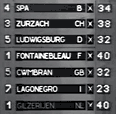 |
|
Additional Information |
|
Games in this heat were based on Walt Disney’s characters and included games
based on Pluto, Goofy and Baloo and Mowgli (The Jungle Book). The Fil
Rouge involved team members costumed as giant vultures (again from The
Jungle Book) having to cross a pool on a wooden beam, to deposit a giant
egg (hidden inside the costume and released as a normal egg would be laid!)
into a basket on the other side. However, if a competitor fell in the pool,
their vulture costume became slippery and heavy with water, making it even
harder to negotiate the beam. Just as in 1974, when many of the British teams took
the names of their local authority, Dutch team Gilze en Rijen became the first
of many Dutch teams to take its name from its local municipality. Comprised of
competitors from the villages of Gilze, Hulten, Molenschot and Rijen, the team
proved more than a match for the rest of Europe (except for France). Leading
three times in the competition, the team found itself in 3rd place before the
final game, two points behind the French and Swiss teams. However, a
convincing win on the final game gave the team seven points and only the
French team, Fontainebleau, finishing 3rd on the game, could equal its
performance. |
|
Made
in Colour • This programme exists in the BBC Archives
Exists in European archives |
|
|
|
GB |
Jeux
Sans Frontières 1977 |
Heat
5 |
|
Event Staged: Tuesday 26th July 1977
Venue:
Home Park, Windsor, Great Britain
European Transmissions (Local Timings):
BRT (B): Tuesday 26th July 1977, 9.05-10.25pm (Live - DST)
RTBF (B): Tuesday 26th July 1977, 9.05-10.25pm (Live - DST)
RAI Due (I): Tuesday 26th July 1977, 9.05-10.25pm (Live - DST)
SSR (CH): Wednesday 27th July 1977, 8.05-10.10pm
TSI (CH): Wednesday 27th July 1977, 9.00-10.30pm
Nederland 1 (NL): Wednesday 27th July 1977, 9.00-10.35pm
SRG (CH): Wednesday 27th July 1977, 9.05-10.25pm
WDR 1 (D): Wednesday 27th July 1977, 10.05-11.30pm
RTP (P): Thursday 28th July 1977,
9.35-11.15pm
Antenne 2 (F): Sunday 21st August 1977
BBC1 Scotland (GB/SCOT): Wednesday 12th October 1977,
6.10-7.25pm
BBC1 (GB exc. Scotland/Wales): Wednesday 12th October 1977,
6.50-8.05pm
BBC1 Wales (CYM): Sunday 16th October 1977, 1.55-3.10pm |
|
Theme:
A Tour of Merrie England |
|
Teams:
Uccle (B) v. Tesserete (CH)
v. Bebra (D) v. Toulon
(F) v.
Windsor and Maidenhead (GB) v. Gubbio (I) v. Landsmeer-Watergang (NL) |
|
Games Demonstration Team: St. Albans (GB) |
|
Team Members
included:
Tesserete (CH) - Kiki Stampononi (Team Captain), Anna
Baruffaldi, Daniele Besomi, Margherita Cattanbo, Mirto de Martini, Adriana
d’Onofrio, Patrizia Fraschina, Ferruccio Landis, Claudio Martinenghi, Giorgio
Menghetti, Ettore Mini, Graziano Morosoli, Jasmine Rinaldi, Raffaele Quadri;
Windsor and Maidenhead (GB) - Mike Revill (Team Captain), Anne
Divall (Women's Team Captain), Dave Barlow, Roger Bowden, Debbie Cronshaw,
Jackie Eaton, Jane Finlan, Michelle Greene, Tony Greene, Emma James, Barry
Mason, Chris Morrell, John Mumford, Jo Oakley, Jean-Pierre Poissonet, John
Randell, Nigel Smith, Suk Sohal, Christine Sturrock and Mike Wakefield. |
|
Games:
Sedan Chairs, The Water Mill, The Highwaymen, Barrels (Tar and Feathers),
Maypole Dancing, Loading the Coach, Stabling the Horses and Penny-Farthing Race;
Fil Rouge: The Innkeeper. |
|
Game
Results and Standings |
|
Games |
|
Team /
Colour |
1 |
2 |
3 |
4 |
5 |
6 |
7 |
FR |
8 |
Points Scored
(Joker games shown in red) |
|
B |
4 |
6 |
--- |
4 |
10 |
5 |
4 |
4 |
6 |
|
CH |
1 |
8 |
4 |
--- |
3 |
2 |
5 |
3 |
5 |
|
D |
2 |
5 |
6 |
3 |
--- |
3 |
2 |
5 |
4 |
|
F |
3 |
3 |
6 |
6 |
6 |
--- |
12 |
1 |
3 |
|
GB |
10 |
1 |
1 |
5 |
4 |
4 |
--- |
6 |
7 |
|
I |
--- |
4 |
2 |
1 |
1 |
1 |
1 |
3 |
1 |
|
NL |
12 |
--- |
5 |
2 |
2 |
6 |
4 |
7 |
2 |
Running Totals
(Leading teams shown in red) |
|
B |
4 |
10 |
10 |
14 |
24 |
29 |
33 |
37 |
43 |
|
CH |
1 |
9 |
13 |
13 |
16 |
18 |
23 |
26 |
31 |
|
D |
2 |
7 |
13 |
16 |
16 |
19 |
21 |
26 |
30 |
|
F |
3 |
6 |
12 |
18 |
24 |
24 |
36 |
37 |
40 |
|
GB |
10 |
11 |
12 |
17 |
21 |
25 |
25 |
31 |
38 |
|
I |
0 |
4 |
6 |
7 |
8 |
9 |
10 |
13 |
14 |
|
NL |
12 |
12 |
17 |
19 |
21 |
27 |
31 |
38 |
40 |
|
|
|
Result |
Team |
Points |
Final Scoreboard |
|
1st
=2nd
=2nd
4th
5th
6th
7th |
B
• Uccle
● ●
F • Toulon
NL • Landsmeer-Watergang
GB • Windsor and Maidenhead
CH • Tesserete
D • Bebra
I • Gubbio |
43
40
40
38
31
30
14 |
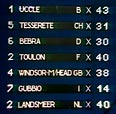 |
|
The Venue |
|
Windsor, Great Britain
This heat in Windsor was set against the backdrop of Windsor Castle, one of the residences of
the British Royal Family. On the night of recording, shadows could be seen at
some of the windows. Was Her Majesty Queen Elizabeth II possibly overseeing the event? |
|
The
Rehearsals |
|
As
was more than often the case in the International Heats, a local team not
involved in the year's JSF competition would be drafted in by the host
broadcaster to demonstrate the games during the lead-in to the big night. The
demonstrations would be attended by all team members and officials and would
be the first sight that teams were afforded of the games prior to their own
rehearsals with the equipment, which were usually held on the day before
recording. For this International Heat in Windsor's Home Park, the team of St.
Albans (who had narrowly missed out on qualification, losing a tie-breaker to
Southend-on-Sea in their It's A Knockout heat) were called in by the
BBC to demonstrate the games to all teams. The picture shows St. Albans team
members Steve Mizsei, William McKenna, Judi Nardi and Tony Smith at the
Windsor venue with presenters Eddie Waring and Stuart Hall. |
|
Additional Information |
|
This was the only time BBC1 Scotland had broadcast Jeux Sans Frontières
at a different time to the rest of the country. Although only 40 minutes
earlier, it was moved in the evening schedule to finish in time for the
channel to carry the World Cup qualifying match between Scotland and Wales
being shown live at 7.30 pm that evening.
The French team Toulon were very strong and wanted desperately
to win this heat. They won four consecutive games (Games 3, 4, 5 and 7 - they
missed Game 6), one of which was their Joker game, and it seemed nothing could
stop them. However, a very disappointing 7th place on the Fil Rouge and only
5th place on the last game enabled Belgian team, Uccle, to win the heat. |
|
Made
in Colour • This programme exists in the BBC Archives |
|
|
|
B |
Jeux
Sans Frontières 1977 |
Heat
6 |
|
Event Staged: Wednesday 10th August 1977
Venue:
Grote Markt (Great Market Square) and Schoenmakersstraat, Antwerpen, Belgium
European Transmissions (Local Timings):
SSR (CH): Wednesday 10th August 1977, 8.05-9.25pm (Live)
TSI (CH): Wednesday 10th August 1977, 9.00-10.30pm
SRG (CH): Wednesday 10th August 1977, 9.05-10.25pm
Nederland 1 (NL): Wednesday 10th August 1977, 9.00-10.30pm (Live - DST)
BRT (B): Wednesday 10th August 1977, 9.05-10.25pm (Live - DST)
RTBF (B): Wednesday 10th August 1977, 9.05-10.25pm (Live - DST)
RAI Due (I): Wednesday 10th August 1977, 9.05-10.25pm (Live - DST)
WDR 1 (D): Wednesday 10th August 1977, 10.05-11.30pm
RTP (P): Saturday 20th August 1977,
5.00-6.30pm
Antenne 2 (F): Sunday 28th August 1977
BBC1 (GB exc. Wales): Wednesday 19th October 1977,
6.50-8.05pm
BBC1 Wales (CYM): Sunday 23rd October 1977, 1.55-3.10pm |
|
Theme:
Reubens the Painter |
|
Teams:
Antwerpen (B) v. Sion (CH)
v. Seelze (D) v. Quimper (F) v.
Southend-on-Sea
(GB) v. Vignola (I) v. Ooststellingwerf (NL) |
|
Team Members included:
Southend-on-Sea (GB) - Peter Bailey, Mike Davison, Lois Gill, Andrew
Lagden, Irene Millington, Debbie Newton, Leonard Todge, Alistair West and
Martin Wilcox; |
|
Games
(Official Titles): Overhandigen van de Sleutel van de Stad (Handing Over
the Key of the City), Rubens in zijn Atelier (Rubens in his Studio),
Modellentransport (Model Transport), Het Stilleven (A Still Life), Oost
West... Thuis Best (There is No Place Like Home), Opsinjoorke in de
Sinjorenstad (Opsinjoorke in the Sinjoren City), Het Palet (The Palette) and
Brabo (Brabo);
Fil Rouge: Ikaros (Icarus). |
|
Game
Results and Standings |
|
Games |
|
Team /
Colour |
1 |
2 |
3 |
4 |
5 |
6 |
7 |
FR |
8 |
Points Scored
(Joker games shown in red) |
|
B |
2 |
5 |
4 |
6 |
2 |
6 |
--- |
6 |
7 |
|
CH |
--- |
2 |
5 |
2 |
5 |
3 |
2 |
1 |
1 |
|
D |
8 |
--- |
6 |
4 |
6 |
1 |
1 |
7 |
3 |
|
F |
3 |
4 |
--- |
2 |
4 |
2 |
6 |
3 |
2 |
|
GB |
2 |
4 |
1 |
--- |
3 |
4 |
3 |
6 |
4 |
|
I |
5 |
1 |
6 |
5 |
--- |
5 |
5 |
2 |
6 |
|
NL |
6 |
6 |
8 |
3 |
5 |
--- |
4 |
4 |
5 |
Running Totals
(Leading teams shown in red) |
|
B |
2 |
7 |
11 |
17 |
19 |
25 |
25 |
31 |
38 |
|
CH |
0 |
1 |
6 |
8 |
13 |
16 |
18 |
19 |
20 |
|
D |
8 |
8 |
14 |
18 |
24 |
25 |
26 |
33 |
36 |
|
F |
3 |
7 |
7 |
9 |
13 |
15 |
21 |
24 |
26 |
|
GB |
2 |
6 |
7 |
7 |
10 |
14 |
17 |
23 |
27 |
|
I |
5 |
6 |
12 |
17 |
17 |
22 |
27 |
29 |
35 |
|
NL |
6 |
12 |
20 |
23 |
28 |
28 |
32 |
36 |
41 |
|
|
|
Result |
Team |
Points |
Final Scoreboard |
|
1st
2nd
3rd
4th
5th
6th
7th |
NL
• Ooststellingwerf
●
B • Antwerpen
D • Seelze
I • Vignola
GB • Southend-on-Sea
F • Quimper
CH • Sion |
41
38
36
35
27
26
20 |
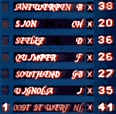 |
|
The Venue |
|
Antwerpen, Belgium
| |
|
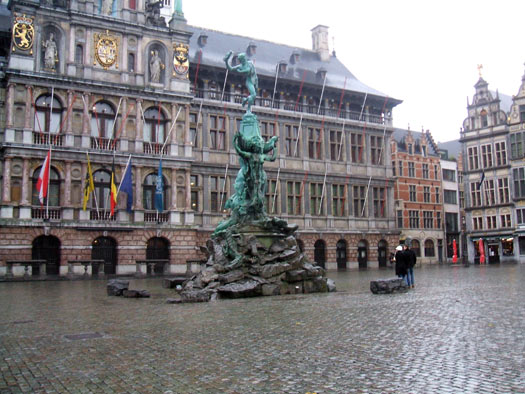 |
|
The Brabofontein (Brabo Fountain)
situated in Antwerpen's Grote Markt
Image ©
Neil Storer, 2008 |
| |
This memorable JSF heat was staged in the beautiful Grote Markt of
Antwerpen,
with the Fil Rouge being held at the entrance to the adjoining
Schoenmakersstraat (see photograph below for the games and camera layout).
Antwerpen, with a population of over half a million is the largest
municipality in Flanders and Belgium and is an economic and cultural hub of
the Low Countries with a rich history which can be dated back to the 2nd
Century AD. It was named Antwerpen in the 4th Century when settled by the
Germanic Franks. The Grote Markt itself contains a striking array of old
buildings, many dating back to the 16th Century, including the guildhouses and
City Hall, built in the Renaissance style and completed in 1565. The original
building was gutted by fire in The Spanish Fury (also known as the Sack of
Antwerpen) of November 1576, a terrible three-day assault upon the city (then
a part of the Netherlands) by the Spanish which left 7000 inhabitants dead and
much property in the city razed to the ground. The outrages were instigated by
militant Spanish tercios angry at heavy delays to receiving payment from their
King, Philip II in reward for their long struggles against the Dutch rebels.
Spain had recently declared bankruptcy and the 400,000 florins payment due the
soldiers had been intercepted by agents of the English monarchy. The incident
triggered a decline in Antwerpen's economic and cultural fortunes and paved
the way for the rise of Amsterdam. The City Hall was repaired and
reconstructed over the following three years and remained substantially
unchanged until the late 19th Century when Pierre Bruno Bourla drastically
modified the interior. Much of the stately decor dates from this period, as
does a roof over what was once an open-air inner courtyard.
|
|
The Games in Detail |
|
Game 1 - Overhandigen van de Sleutel van de Stad
(Handing Over the Key of the City)
| |
|
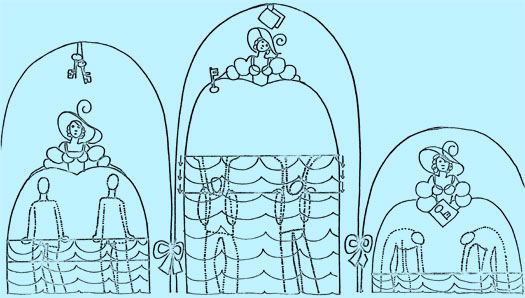 |
|
Image © BRT / VRT, 1977 |
| |
|
Running Scores and Positions:
1st Seelze (D) (8pts awarded / Joker / 8pts
total)
2nd Ooststellingwerf (NL) (6pts / 6pts)
3rd Vignola (I) (5pts / 5pts)
4th Quimper (F) (3pts / 3pts)
=5th Antwerpen (B) (2pts / 2pts)
=5th Southend-on-Sea (GB) (2pts / 2pts)
7th Sion (CH) (--- / 0pts) |
Game 2 - Rubens in zijn Atelier (Rubens in his Studio)
| |
|
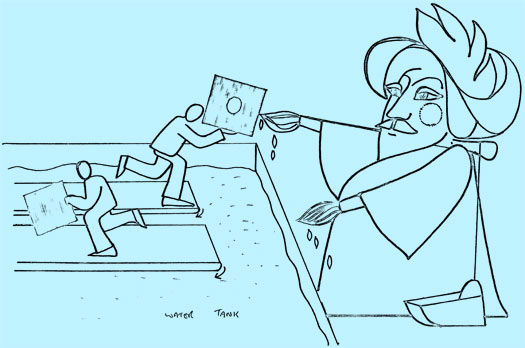 |
|
Image © BRT / VRT, 1977 |
| |
|
Running Scores and Positions:
1st Ooststellingwerf (NL) (6pts awarded /
12pts total) ▲
2nd Seelze (D) (--- / 8pts) ▼
=3rd Antwerpen (B) (5pts / 7pts) ▲
=3rd Quimper (F) (4pts / 7pts) ▲
=5th Southend-on-Sea (GB) (4pts / 6pts)
=5th Vignola (I) (1pt / 6pts) ▼
7th Sion (CH) (1pt / 1pt) |
Game 3 - Modellentransport (Model Transport)
| |
|
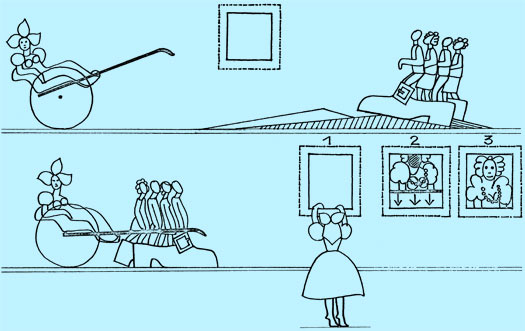 |
|
Image © BRT / VRT, 1977 |
| |
|
Running Scores and Positions:
1st Ooststellingwerf (NL) (8pts awarded /
Joker / 20pts total)
2nd Seelze (D) (6pts / 14pts)
3rd Vignola (I) (6pts / Joker / 12pts) ▲
4th Antwerpen (B) (4pts / Joker / 11pts) ▼
=5th Quimper (F) (--- / 7pts) ▼
=5th Southend-on-Sea (GB) (1pts / 7pts)
7th Sion (CH) (5pts / 6pts) |
Game 4 - Het Stilleven (A Still Life)
| |
|
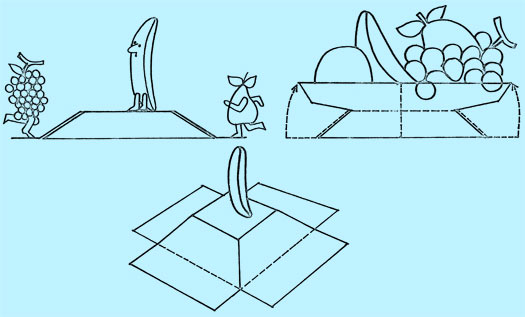 |
|
Image © BRT / VRT, 1977 |
| |
|
Running Scores and Positions:
1st Ooststellingwerf (NL) (3pts awarded /
23pts total)
2nd Seelze (D) (4pts / 18pts)
=3rd Antwerpen (B) (6pts / 17pts) ▲
=3rd Vignola (I) (5pts / 17pts)
5th Quimper (F) (2pts / 9pts)
6th Sion (CH) (2pts / Joker / 8pts) ▲
7th Southend-on-Sea (GB) (--- / 7pts) ▼ |
|
Comments:
This game was arguably the funniest of the night
with competitors dressed as pieces of fruit and having to climb into a
huge fruit bowl. This game would become familiar in subsequent events, as
it was re-used on many occasions.
On the night, the Belgian, West German and
Italian teams seemed to have no difficulty with the game, but the Swiss
(playing their Joker), French and Dutch teams seemed not to have a clue
how to get its fruit into the bowl, and hilarious results ensued. Not only
was BBC commentator Stuart Hall in fits of hysterics, but the crowd could
clearly be heard laughing in the Grote Markt of Antwerpen. |
Game 5 - Oost West... Thuis Best (There is No Place Like Home)
| |
|
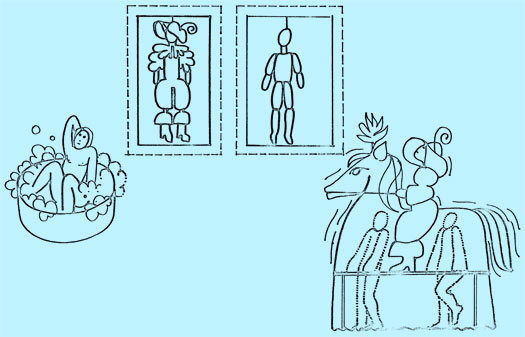 |
|
Image © BRT / VRT, 1977 |
| |
|
Running Scores and Positions:
1st Ooststellingwerf (NL) (5pts awarded /
28pts total)
2nd Seelze (D) (6pts / 24pts)
3rd Antwerpen (B) (2pts / 19pts)
4th Vignola (I) (--- / 17pts) ▼
=5th Sion (CH) (5pts / 13pts) ▲
=5th Quimper (F) (4pts / Joker / 13pts)
7th Southend-on-Sea (GB) (3pts / 10pts) |
Game 6 - Opsinjoorke in de Sinjorenstad
(Opsinjoorke in the Sinjoren City)
| |
|
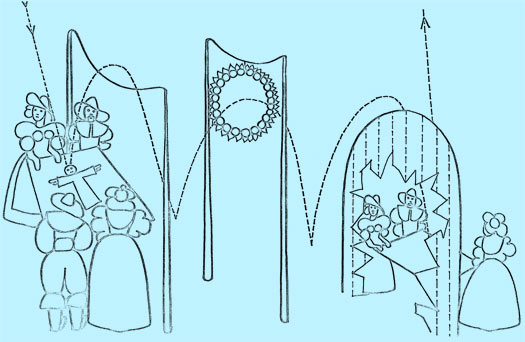 |
|
Image © BRT / VRT, 1977 |
| |
|
Running Scores and Positions:
1st Ooststellingwerf (NL) (--- awarded / 28pts
total)
=2nd Antwerpen (B) (6pts / 25pts) ▲
=2nd Seelze (D) (1pt / 25pts)
4th Vignola (I) (5pts / 22pts)
5th Sion (CH) (3pts / 16pts)
6th Quimper (F) (2pts / 15pts) ▼
7th Southend-on-Sea (GB) (4pts / 14pts) |
Game 7 - Het Palet (The Palette)
| |
|
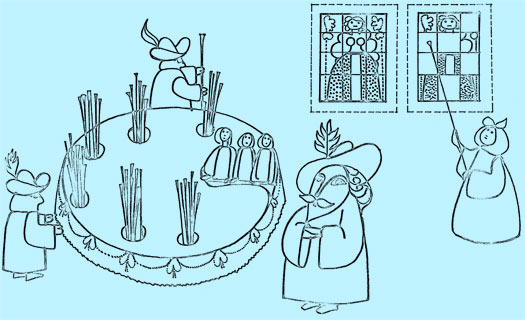 |
|
Image © BRT / VRT, 1977 |
| |
|
Running Scores and Positions:
1st Ooststellingwerf (NL) (4pts awarded /
32pts total)
2nd Vignola (I) (5pts / 27pts) ▲
3rd Seelze (D) (1pt / 26pts) ▼
4th Antwerpen (B) (--- / 25pts) ▼
5th Quimper (F) (6pts / 21pts) ▲
6th Sion (CH) (2pts / 18pts) ▼
7th Southend-on-Sea (GB) (3pts / 17pts) |
Fil Rouge - Ikaros (Icarus)
| |
|
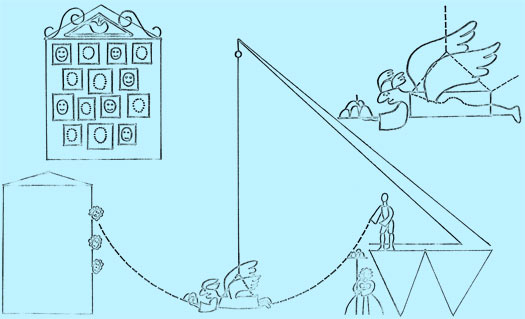 |
|
Image © BRT / VRT, 1977 |
| |
|
Final Fil Rouge Standings:
1st Seelze (D)
=2nd Antwerpen (B)
=2nd Southend-on-Sea (GB)
4th Ooststellingwerf (NL)
5th Quimper (F)
6th Vignola (I)
7th Sion (CH) |
|
Running Scores and Positions:
1st Ooststellingwerf (NL) (4pts awarded /
36pts total)
2nd Seelze (D) (7pts / 33pts) ▲
3rd Antwerpen (B) (6pts / 31pts) ▲
4th Vignola (I) (2pts / 29pts) ▼
5th Quimper (F) (3pts / 24pts)
6th Southend-on-Sea (GB) (6pts / 23pts) ▲
7th Sion (CH) (1pt / 19pts) ▼ |
Game 8 - Brabo (Brabo)
| |
|
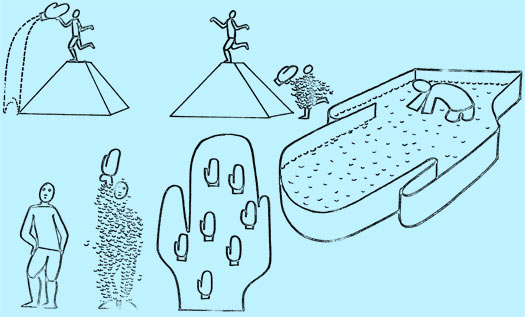 |
|
Image © BRT / VRT, 1977 |
| |
|
Final Scores and Positions:
1st Ooststellingwerf (NL) (5pts awarded /
41pts total)
2nd Antwerpen (B) (7pts / 38pts) ▲
3rd Seelze (D) (3pts / 36pts) ▼
4th Vignola (I) (6pts / 35pts)
5th Southend-on-Sea (GB) (4pts / 27pts) ▲
6th Quimper (F) (2pts / 26pts) ▼
7th Sion (CH) (1pt / 20pts) |
|
|
Additional Information |
|
The Dutch team of Ooststellingwerf became the second Dutch team this year to
take its name from its local municipality. Made up of competitors from the villages of Appelscha, Elsloo,
Oosterwolde and numerous other hamlets, the team proved more than a match for
the rest of Europe. After winning the first two games, and finishing 3rd on
their Joker game (Game 3), the team streaked to the top of the standings early
on and never looked back after that.
|
|
Made
in Colour • This programme exists in the BBC Archives |
|
|
|
NL |
Jeux
Sans Frontières 1977 |
Heat
7 |
|
Event Staged: Wednesday 24th August 1977
Venue:
De Bleek, Doetinchem, Netherlands
European Transmissions (Local Timings):
SSR (CH): Wednesday 24th August 1977, 8.05-9.30pm (Live)
SRG (CH): Wednesday 24th August 1977, 8.05-9.35pm (Live)
TSI (CH): Wednesday 24th August 1977, 9.00-10.20pm
Nederland 2 (NL): Wednesday 24th August 1977, 9.00-10.30pm (Live - DST)
BRT (B): Wednesday 24th August 1977, 9.05-10.25pm (Live - DST)
RTBF (B): Wednesday 24th August 1977, 9.05-10.25pm (Live - DST)
RAI Due (I): Wednesday 24th August 1977, 9.05-10.30pm (Live - DST)
WDR 1 (D): Wednesday 24th August 1977, 10.05-11.30pm
RTP (P): Saturday 3rd September 1977,
5.05-6.35pm
Antenne 2 (F): Sunday 4th September 1977
BBC1 (GB exc. Wales): Wednesday 26th October 1977,
6.50-8.05pm
BBC1 Wales (CYM): Sunday 30th October 1977, 1.55-3.10pm |
|
Theme:
Dutch Agriculture |
|
Teams:
La Calamine (B)
v. Scuol (CH) v. Limburg an der Lahn (D)
v.
Bourgoin-Jallieu (F) v.
Crawley (GB) v. Viterbo (I) v. Doetinchem (NL) |
|
Team Members
included:
La Calamine (B) - Marianne Ubachs, Erben Lamour;
Crawley (GB - Full Squad) - Ron Brooks (Co-Team Manager), Jack
Chapman (Co-Team Manager), Lee Creasey (Team Coach), Margaret Salter (Women's
Team Coach), Aideen Brooks, Malcolm Calloway, Nick Cannon, John Cave, David
Clifton, Shirley Cook, Lesley Davison, Jackie Dawson, Kathleen Howells, Barry
Hyslop, Penelope Lewis, Paul Norris, Roger Pitts, Ian Prebble, Patricia
Quinlan, Anthony Rea, Paul Roberts, Ann Rye, Margaret Salter, David Smith,
Martin Smith, Simon Taylor, Simon Tubb, Maurice Ward, Jeffrey Young;
Viterbo (I) - Laura Rosetti;
Doetinchem (NL) - Joop Keizer (Team Captain), Francis Bles, Hans
Bloem, Henriet Bout, Flora te Braak-Jonkman, H. J. Beumer, Willy Harmsen, René
Hilgers, Gerard ter Horst, Hendrik Martens, Henk Mulder, Jan Rougoor, Jos
Schippers, Peter Vallen, Aukje Vollema, Gerdien Weening, Bert van Wezenbeek. |
|
Games
(Official Titles): Grote Kazenrace (Giant Cheese Race), De Molenaars (The
Millers), Kaasbrug (The Cheese Bridge), Wie Durft (The Courage Test), De
Acrobaten (The Acrobats), De Kat en de Muizen (The Cat and the Mice), De
Kaasdragers (The Cheese-Bearers), De Varkens (The Pigs);
Fil Rouge: De Trouwerij (The Wedding);
Jokers: Mills. |
|
Game
Results and Standings |
|
Games |
|
Team /
Colour |
1 |
2 |
3 |
4 |
5 |
6 |
7 |
FR |
8 |
Points Scored
(Joker games shown in red) |
|
B |
--- |
4 |
1 |
3 |
6 |
2 |
3 |
4 |
3 |
|
CH |
5 |
--- |
6 |
1 |
1 |
10 |
5 |
7 |
4 |
|
D |
1 |
2 |
--- |
3 |
6 |
10 |
1 |
1 |
2 |
|
F |
12 |
5 |
2 |
--- |
4 |
3 |
4 |
6 |
7 |
|
GB |
3 |
3 |
3 |
3 |
--- |
1 |
12 |
5 |
6 |
|
I |
4 |
1 |
8 |
3 |
2 |
--- |
2 |
1 |
1 |
|
NL |
3 |
12 |
5 |
1 |
5 |
6 |
--- |
3 |
5 |
Running Totals
(Leading teams shown in red) |
|
B |
0 |
4 |
5 |
8 |
14 |
16 |
19 |
23 |
26 |
|
CH |
5 |
5 |
11 |
12 |
13 |
23 |
28 |
35 |
39 |
|
D |
1 |
3 |
3 |
6 |
12 |
22 |
23 |
24 |
26 |
|
F |
12 |
17 |
19 |
19 |
23 |
26 |
30 |
36 |
43 |
|
GB |
3 |
6 |
9 |
12 |
12 |
13 |
25 |
30 |
36 |
|
I |
4 |
5 |
13 |
16 |
18 |
18 |
20 |
21 |
22 |
|
NL |
3 |
15 |
20 |
21 |
26 |
32 |
32 |
35 |
40 |
|
|
|
Result |
Team |
Points |
Final Scoreboard |
|
1st
2nd
3rd
4th
=5th
=5th
7th |
F
• Bourgoin-Jallieu
● ●
NL • Doetinchem
CH • Scuol
GB • Crawley
B • La Calamine
D • Limburg an der Lahn
I • Viterbo |
43
40
39
36
26
26
22 |
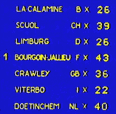 |
|
The Host
Town |
|
Doetinchem, Gelderland
Doetinchem is a town of around 57,000 inhabitants in the
province of Gelderland. It is located 105km (65¼ miles) south-east of
Amsterdam, 122km (75¾ miles) north of Heerlen in the far south, 141km (87½
miles) south of Groningen in the far north and, given the obscure shape of the
country, it lies just 12km (7½ miles) north of the German border town of
Emmerich am Rhein. The town’s boundaries straddle the Oude IJssel (Old Ijssel)
river, in a part of the province called the Achterhoek, at an elevation of
just 14m (45ft 11in) above sea level.
The
first reference to the name of Doetinchem is around AD 838 in a document which
mentions ‘Duetinghem’, a settlement with a small church. In AD 887, there is
another mention of ‘Deutinkem’, a fortress with a church which had been given
to the then Bishop of Utrecht. For a long time, Doetinchem remained a small
place but around 1100 it started to grow and in 1236, Doetinchem was granted
city rights by Count Otto II of Gelre and Zutphen, and in return the town
provided taxes and soldiers for the Count’s army. In 1226, after suffering
from several attempts by plunderers, the town’s wall was raised by a metre
(3ft 3in). There were four barriers in the wall which, being weak points, were
replaced over time by four large city-gates known as the Hamburgerpoort, the
Waterpoort, the Gruitpoort and the Hezenpoort. Later a moat was dug around the
wall and a rampart was built in front. The town’s central windmill, De
Walmolen (Dutch ‘wal’ = wall and ‘molen’ = mill), stands on the remains of
this rampart. Despite these defences, Doetinchem was besieged many times and
during the Eighty Years' War (1568-1648) was besieged and conquered twice.
However, eventually the walls became seen as redundant (or perhaps
ineffective) and in 1672, they were torn down. However, it was not until the
second half of the 19th century that the city-gates and most of the ramparts
were removed.
From its early years, Doetinchem had been an important market-place for
farmers to sell their wares with a market held in the central square,
Simonsplein, right up until the Second World War. The town also has three
windmills. In the town centre, there is the already mentioned De Walmolen
(built 1851) with a sail span of 23m (75ft 5½in), Aurora (1870) with a
sail span of 20.66m (67ft 9½in) and Benninkmolen (1921), the largest of
the three with a sail span of 23.1m (75ft 9¾in). All these mills are open to
visitors, usually on one weekday morning and at other times by appointment.
An
interesting and fascinating point about the town’s museum, De Stadmuseum, is
that it has had quite a colourful history since it first opened in the early
part of the 19th century. Starting off in the cellar of the town’s castle, it
was moved to a former prison building in Nieuwstadstraat. Another move
followed to 27 Grutstraat, the site of a former hairdressing salon. A final
move in 2011 to its present home, was to 2 Nispenstraat, the site of the
former post office.
|
|
The Games in Detail |
|
Game 1 - Grote Kazenrace (Giant Cheese Race)
1 heat of 6 teams. 1 girl and 2 boys. The girl is perched on top of a cheese
(a large ball, partly filled with water). The boys roll the ball, with the
girl on top, towards a small bridge. The bridge is built up from mattresses,
unevenly arranged. At the end of the course the girl, who is still on the
cheese, pulls a cord, to display the corresponding country's initials. Teams
are awarded points in order of arrival.
| |
|
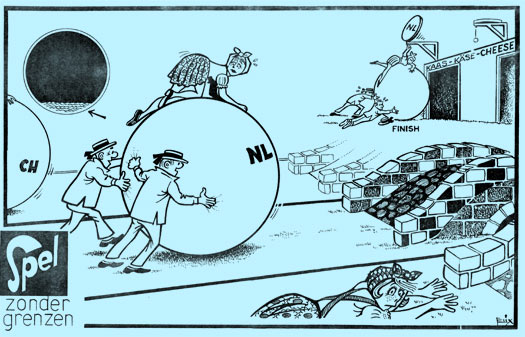 |
|
Image ©
Felix / NCRV, 1977 |
| |
|
Running Scores and Positions:
1st Bourgoin-Jallieu (F) (12pts awarded /
Joker / 12pts
total)
2nd Scuol (CH) (5pts / 5pts)
3rd Viterbo (I) (4pts / 4pts)
=4th Crawley (GB) (3pts / 3pts)
=4th Doetinchem (NL) (3pts / 3pts)
6th Limburg an der Lahn (D) (1pt / 1pt)
7th La Calamine (B) (--- / 0pts) |
Fil Rouge - De Trouwerij (The Wedding)
1 girl and 3 boys. A bride and groom exit from the mill. The
groom drives his bride to the dyke. The dyke is a slippery slope, ten metres
long. When they have arrived on the top of the dyke the bride and groom slide
down in a little boat. On the quay of the other side the "official of the
Registrar's office" is jumping up and down on a plank. A rope, tied to the
boat, passes under the plank. Another official, in the Town Hall, is pulling
the rope to haul the boat to the edge of the water. All participants enter the
Town Hall, where the bride and groom hang out the flag of their country, from
an upper floor window. The game is won by the team achieving the best time.
| |
|
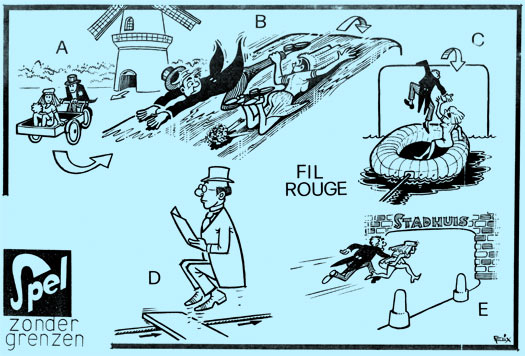 |
|
Image ©
Felix / NCRV, 1977 |
| |
Game 2 - De Molenaars (The Millers)
3 heats of 2 teams. 1 girl and 3 boys. Three millers are pushing a hand-cart
loaded with bags of flour toward the mill. The girl, dressed as a farmer's
wife, is sitting on the bags. Two of the boys climb up by means of the
hoisting rope. The third boy and the girl put the bags on a pallet, The pallet
is then hoisted up, and the two boys in the mill throw the bags in a trough,
for weighing. The team which has collected the greatest weight, wins the game.
| |
|
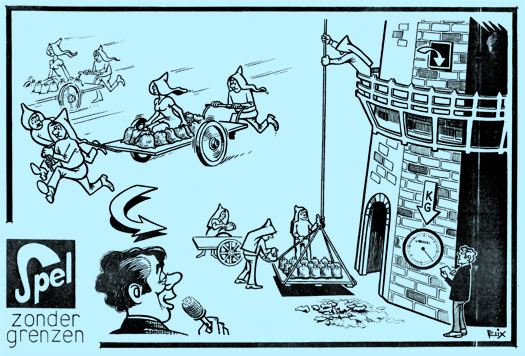 |
|
Image ©
Felix / NCRV, 1977 |
| |
The French team from Bourgoin-Jallieu
encountered a problem: a mechanism inside their mill broke and the mill became
blocked with sacks. The team were granted a second run and their score in this
rerun was good enough for second place on the game.
|
Running Scores and Positions:
1st Bourgoin-Jallieu (F) (5pts awarded /
17pts
total)
2nd Doetinchem (NL) (12pts / Joker / 15pts)
▲
3rd Crawley (GB) (3pts / 6pts) ▲
=4th Scuol (CH) (--- / 5pts) ▼
=4th Viterbo (I) (1pt / 5pts) ▼
6th La Calamine (B) (4pts / 4pts) ▲
7th Limburg an der Lahn (D) (2pts / 3pts) ▼ |
Game 3 - Kaasbrug (The Cheese Bridge)
2 heats of 3 teams. 2 girls, team captain and assistant team captain. Two
girls stand on a bridge which works as a seesaw. The team captain, who is to
pass the cheeses, is standing at the start. The first girl passes the cheese
on to the second girl who, in turn, hands the cheese to the assistant team
captain, who is at the other end of the bridge, "on shore". The object of the
game is, therefore, to carry as many cheeses as possible across the bridge, by
proper balancing and concerted action. The team which has carried the most
cheeses across, wins.
| |
|
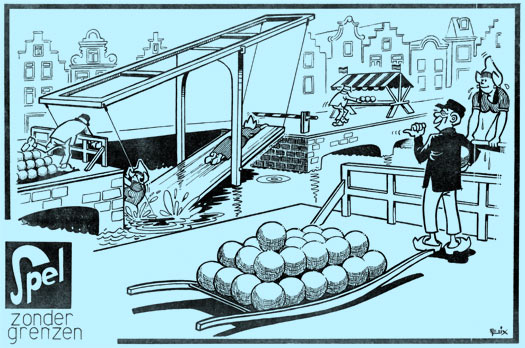 |
|
Image ©
Felix / NCRV, 1977 |
| |
|
Running Scores and Positions:
1st Doetinchem (NL) (5pts awarded / 20pts
total) ▲
2nd Bourgoin-Jallieu (F) (2pts / 19pts) ▼
3rd Viterbo (I) (8pts / Joker / 13pts) ▲
4th Scuol (CH) (6pts / 11pts)
5th Crawley (GB) (3pts / 9pts) ▼
6th La Calamine (B) (1pt / 5pts)
7th Limburg an der Lahn (D) (--- / 3pts) |
Game 4 - Wie Durft (The Courage Test)
6 teams simultaneously - elimination race. 1 boy per team. The participants
are standing at the start, wearing large "wooden shoes" made of foam plastic,
on a starting-place. In front of the participants are farm tractors. When the
starting gun is fired the clocks next to the participants (showing the times
in seconds) start running, and the tractors are pulled towards the finish, all
six at the same time. The thing to do is, to stop the tractor before it
reaches the stand with the milk churns and pails. The participants keep their
positions at the start as long as they dare, and start running to their
tractor to stop it, at what they think is the very last moment! As soon as
they step off the plate at the start their clock stops. The participant whose
tractor topples the stand with the churns and pails is eliminated anyway. The
next one to be taken out of the race is the participant whose clock shows the
lowest number of seconds.
| |
|
 |
|
Image ©
Felix / NCRV, 1977 |
| |
This
game resulted in a very unusual outcome. It featured
six tractors which were pulled mechanically down the course towards a row of
milk cans. Behind the tractors, there were six 'farmers' wearing gigantic
clogs and the winner would be the player who held their nerve longest and
stopped the tractor closest to the milk cans before the tractor hit them. The
game was planned to be played out over three heats, with the last placed team
eliminated in the first and the fourth and fifth placed teams decided in the
second heat. Three teams would have played out the final. However, it did not
go to plan! In the first heat, two teams - the Swiss and the Dutch - failed to
stop the tractors in time, and their milk cans were both knocked over. It was
decided to eliminate both teams, leaving them tied in 6th place with 1pt each
and run the second heat with four teams instead of the planned five,
eliminating one instead of two. However, the second heat didn't run to plan
either and as a result, the third heat was abandoned... This was because in
the second run, none of the four teams stopped their tractor in time and all
the remaining milk cans were tipped over. Referees Gennaro Olivieri and Guido
Pancaldi announced that this meant that all teams were eliminated and would be
awarded 3pts each for a joint 4th place finish. This is the first and only time this happened in the history of
Jeux Sans Frontières.
|
Running Scores and Positions:
1st Doetinchem (NL) (1pt awarded / 21pts
total)
2nd Bourgoin-Jallieu (F) (--- / 19pts)
3rd Viterbo (I) (3pts / 16pts)
=4th Scuol (CH) (1pt / 12pts)
=4th Crawley (GB) (3pts / 12pts) ▲
6th La Calamine (B) (3pts / 8pts)
7th Limburg an der Lahn (D) (3pts / 6pts) |
Game 5 - De Acrobaten (The Acrobats)
6 heats of 1 team. 2 girls and 4 boys per team. Some kind of scaffolding is
constructed over a wash-tub. Several baskets are mounted on the scaffolding.
The playing team members try to swing to the other side by means of the flying
trapezes. One boy of each of the other teams tries to throw balls into the
baskets, to make the trapeze that hangs from a basket drop off. As trapezes
fall off it becomes progressively more difficult for a team to reach the other
side. The playing team may try to make as many passages as the participants
want, within the allotted time. The game is won by the team which has made the
most completed passages.
| |
|
 |
|
Image ©
Felix / NCRV, 1977 |
| |
|
Running Scores and Positions:
1st Doetinchem (NL) (5pts awarded / 26pts
total)
2nd Bourgoin-Jallieu (F) (4pts / 23pts)
3rd Viterbo (I) (2pts / 18pts)
4th La Calamine (B) (6pts / Joker / 14pts) ▲
5th Scuol (CH) (1pt / 13pts) ▼
=6th Limburg an der Lahn (D) (6pts / 12pts) ▲
=6th Crawley (GB) (--- / 12pts) ▼ |
Game 6 - De Kat en de Muizen (The Cat and the Mice)
3 heats of 2 teams. 2 girls and 2 boys per team. Both boys are in the "cat",
which lies on a large chair, When the starting signal is given, the cat runs
to the cheese, and pulls it down. When the cheese lies on one side, two girls
- dressed as mice - run towards the trap. The cat chases the mice, who are
able to pass through two holes in the trap, which the cat cannot. As soon as
the cat has been caught in the trap the mice pull the lid on the back of the
trap, shutting it. The game is won by the team achieving the best time.
| |
|
 |
|
Image ©
Felix / NCRV, 1977 |
| |
|
Running Scores and Positions:
1st Doetinchem (NL) (6pts awarded / 32pts
total)
2nd Bourgoin-Jallieu (F) (3pts / 26pts)
3rd Scuol (CH) (10pts / Joker / 23pts) ▲
4th Limburg an der Lahn (D) (10pts / Joker / 22pts) ▲
5th Viterbo (I) (--- / 18pts) ▼
6th La Calamine (B) (2pts / 16pts) ▼
7th Crawley (GB) (1pt / 13pts) ▼ |
Game 7 - De Kaasdragers (The Cheese-Bearers)
2 heats of 3 teams. 2 boys per team. When the starting signal
has been given the two boys stack all cheese on a typical cheese-barrow. The
barrow is then carried, in the traditional way, to the finish over and through
various obstacles. The game is won by the team achieving the best time.
| |
|
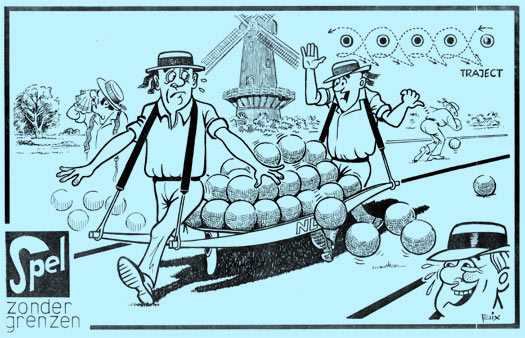 |
|
Image ©
Felix / NCRV, 1977 |
| |
|
Running Scores and Positions:
1st Doetinchem (NL) (--- awarded / 32pts
total)
2nd Bourgoin-Jallieu (F) (4pts / 30pts)
3rd Scuol (CH) (5pts / 28pts)
4th Crawley (GB) (12pts / Joker / 25pts) ▲
5th Limburg an der Lahn (D) (1pt / 23pts) ▼
6th Viterbo (I) (2pts / 20pts) ▼
7th La Calamine (B) (3pts / 19pts) ▼ |
Fil Rouge - De Trouwerij (The Wedding)
In this heat's Fil Rouge - 'De Trouwerij (The Wedding)' - the
German and Italian teams were disqualified and as a result, were placed in a
joint 7th position and received 1pt each.
|
Final Fil Rouge Standings:
1st Scuol (CH)
2nd Bourgoin-Jallieu (F)
3rd Crawley (GB)
4th La Calamine (B)
5th Doetinchem (NL)
=7th Limburg an der Lahn (D)
=7th Viterbo (I) |
|
Running Scores and Positions:
1st Bourgoin-Jallieu (F) (6pts awarded /
36pts total)
=2nd Scuol (CH) (7pts / 35pts) ▲
=2nd Doetinchem (NL) (3pts / 35pts) ▼
4th Crawley (GB) (5pts / 30pts)
5th Limburg an der Lahn (D) (1pt / 24pts)
6th La Calamine (B) (4pts / 23pts) ▲
7th Viterbo (I) (1pt / 21pts) ▼ |
Game 8 - De Varkens (The Pigs)
7 teams simultaneously. 1 girl and 3 boys per team. The girl
turns a handle to open a partition, to let out the "pig" hiding the two boys.
Halfway down the course the third boy, dressed as a farmer, is waiting to jump
on the pig's back; the pig then continues its course carrying the farmer. The
pig is very slippery and wide, which makes it hard for the farmer to keep
hanging on. The game is won by the team whose pig, still carrying the farmer,
finishes first.
| |
|
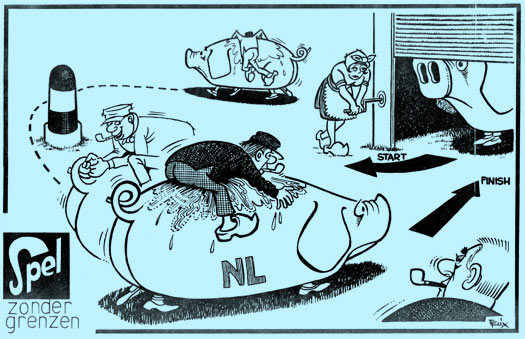 |
|
Image ©
Felix / NCRV, 1977 |
| |
|
Final
Scores and Positions:
1st Bourgoin-Jallieu (F) (7pts awarded /
43pts total)
2nd Doetinchem (NL) (5pts / 40pts)
3rd Scuol (CH) (4pts / 39pts) ▼
4th Crawley (GB) (6pts / 36pts)
=5th La Calamine (B) (3pts / 26pts) ▲
=5th Limburg an der Lahn (D) (2pts / 26pts)
7th Viterbo (I) (1pt / 22pts) |
|
|
Presenters, Officials and Production Team |
|
In this International Heat, referees Guido Pancaldi and Gennaro Olivieri were
shown being weighed on a balance that was designed for weighing cheese. The
weight of the two referees turned out to be 190 kilogram. |
|
Additional Information |
|
This Dutch International Heat, the Netherlands last prior to
their withdrawal from Jeux Sans Frontières, was originally set to be held in
Scheveningen. This proved to be too difficult a location for technical reasons
- the low sunset there would have proved difficult in terms of lighting for
the cameras. Additionally, it proved impossible to shut the boulevard venue
for the period needed to construct the games and grandstands - reputedly three
weeks.
Props and equipment used in this International Heat included
4,000 square metres of firewood, 275 kilograms of glue (and 40 brushes),
180,000 litres of water for the pools, 320 metres of reinforced steel, 133
metres of jute, 25 packages of utility knives, 300 metres of agricultural
plastic, 875 kilograms of flame-retardent paper, 225 foam rubber balls, 570
metres of round pipe, 90 rolls of tape and metres of corrugated fibreboard,
wrapping paper and chipboard.
The three of the four competitors that the Swiss team of Scuol
fielded to tackle the Fil Rouge had a common bond - they were brothers. Their
spirit of camaraderie was obviously valuable, as they along with their female
colleague, won the Fil Rouge for Switzerland and scored the maximum seven
points. |
|
Made
in Colour • This programme exists in the BBC Archives |
|
|
|
Teams
Qualifying for International Final |
|
Country |
Team |
Qualifying Heat |
Position |
Points |
|
B |
Uccle |
5 |
GB |
1 |
43 |
|
CH |
Olivone |
2 |
F |
1 |
40 |
|
D |
Schliersee |
1 |
I |
2 |
38 |
|
F |
Bourgoin-Jallieu |
7 |
NL |
1 |
43 |
|
GB |
Oldham |
2 |
F |
2 |
37 |
|
I |
Marina di Carrara |
1 |
I |
1 |
50 |
|
NL |
Nieuwegein |
3 |
CH |
1 |
47 |
|
|
|
|
|
D |
Jeux
Sans Frontières 1977 |
International
Final |
|
Event Staged: Wednesday 7th September 1977
Venue:
Residenzschloß (Royal Palace), Ludwigsburg, West Germany
European Transmissions (Local Timings):
SSR (CH): Wednesday 7th September 1977, 8.05-9.30pm (Live)
TSI (CH): Wednesday 7th September 1977, 8.05-9.20pm (Live)
Nederland 1 (NL): Wednesday 7th September 1977, 9.00-10.30pm (Live - DST)
BRT (B): Wednesday 7th September 1977, 9.05-10.25pm (Live - DST)
RTBF (B): Wednesday 7th September 1977, 9.05-10.25pm (Live - DST)
RAI Due (I): Wednesday 7th September 1977, 9.05-10.30pm (Live - DST)
SRG (CH): Wednesday 7th September 1977, 9.10-10.30pm
WDR 1 (D): Wednesday 7th September 1977, 10.05-11.30pm
Antenne 2 (F): Sunday 11th September 1977
RTP (P): Saturday 17th September 1977,
5.00-6.30pm
BBC1 (GB exc. Wales): Wednesday 2nd November 1977,
6.50-8.05pm
BBC1 Wales (CYM): Sunday 6th November 1977, 1.55-3.10pm |
|
Theme:
Baroque Splendour |
|
Teams:
Uccle (B) v. Olivone (CH) v. Schliersee (D) v. Bourgoin-Jallieu (F) v.
Oldham (GB) v. Marina di Carrara (I) v. Nieuwegein (NL) |
|
Team Members
included:
Olivone (CH) - Dino Solari (Team Captain), Ortensio Bassi, Lauro
Beffa, Edy Beretta, Barbara Cima, Ortensia Genucchi, Vincenzo Giuliani,
Rolande Hirter, Renzo Jacomett, Lucia Poglia, Loris Solari, Fernando Vini,
Renzo Zanetti, Roberto Zanetti;
Oldham (GB) - Derek Smallwood (Team Manager), Dorothy
Emerson (Women's Team Manager), Tom
Hill (Assistant Team Coach), Diane Cook (Assistant Team Coach), Stephen Andrews,
Sheila Antrobus, Lynne Bowden, Johnathon Boyce,
Michael Cannon, Frank Collinson, Carol Driver, Nadia Duda, Tony Edwards, Don
Errock, Eric Fitzsimmons, Barry Gordon, Karen Halliwell, Ian Hamilton, Warren
Hilton, Syd Jolley, Steve Kenney, Alex Kerrigan, Ruth Lawson, Michael Maloney,
Nicholas Marrington, Mark McLoughlin, Tony Nanyn,
Fiona Nicholl, Brian Parkinson, Christine Silk, Bob Tait, Alison Turner, Jane
Welton;
Marina di Carrara (I) - Massimo Bedini (Team Captain), Giorgio
Andrei, Patrizio Arata, Graziana Arcolini, Patrizia Baccioli, Pietro Baruzzo, Elisabetta Buracchioli, Alessandro Lambruschi, Luca Leati, Stefano Menconi,
Cleta Montefiore, Silvano Santucci, Massimo Tedeschi;
Nieuwegein (NL) - Jaap Ruizeveld (Co-Team Manager), Jaap Verweij (Co-Team
Manager), Lenie Lens-Gerrietsen
(Team Coach), Henk Vonk (Team Captain), Herman Elbertse, Ad Epping, Gerard
Evers, Yvonne Hoefs, Jan van Kippersluis, Ina van der Linden, Maarten Oomen,
Martin Plink, Margot Posthouwer, Lida Raaphorst, Emiel Schaap, Johan van Wijk.
Reserves: Max Bé, Agnes Ritmeester. |
|
Games:
Planting the Flowers, Sedan Chairs, Ballet Dancers, Hobby Horses, Football,
Snuff Box, Watering the Flowers and Changing the Guard;
Fil Rouge: Coachmen and Horses. |
|
Game
Results and Standings |
|
Games |
|
Team /
Colour |
1 |
2 |
3 |
4 |
5 |
6 |
7 |
FR |
8 |
Points Scored
(Joker games shown in red) |
|
B |
4 |
3 |
--- |
10 |
2 |
4 |
2 |
5 |
6 |
|
CH |
1 |
--- |
4 |
8 |
4 |
5 |
2 |
7 |
4 |
|
D |
4 |
6 |
6 |
12 |
6 |
2 |
--- |
4 |
7 |
|
F |
--- |
4 |
2 |
1 |
3 |
12 |
6 |
2 |
2 |
|
GB |
6 |
5 |
3 |
6 |
--- |
3 |
5 |
1 |
3 |
|
I |
6 |
2 |
1 |
--- |
5 |
1 |
8 |
3 |
1 |
|
NL |
4 |
1 |
5 |
4 |
2 |
--- |
3 |
7 |
5 |
Running Totals
(Leading teams shown in red) |
|
B |
4 |
7 |
7 |
17 |
19 |
23 |
25 |
30 |
36 |
|
CH |
1 |
1 |
5 |
13 |
17 |
22 |
24 |
31 |
35 |
|
D |
4 |
10 |
16 |
28 |
34 |
36 |
36 |
40 |
47 |
|
F |
0 |
4 |
6 |
7 |
10 |
22 |
28 |
30 |
32 |
|
GB |
6 |
11 |
14 |
20 |
20 |
23 |
28 |
29 |
32 |
|
I |
6 |
8 |
9 |
9 |
14 |
15 |
23 |
26 |
27 |
|
NL |
4 |
5 |
10 |
14 |
16 |
16 |
19 |
26 |
31 |
|
|
|
Result |
Team |
Points |
Final Scoreboard |
|
1st
2nd
3rd
=4th
=4th
6th
7th |
D
• Schliersee
●
B • Uccle
●
CH • Olivone
●
F • Bourgoin-Jallieu
GB • Oldham
NL • Nieuwegein
I • Marina di Carrara |
47
36
35
32
32
31
27 |
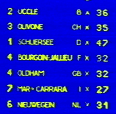 |
|
Additional Information |
|
This edition saw the last appearance of the blue electronic scoreboard which
listed the countries in fixed alphabetical order. From 1978, a new scoreboard
was introduced which could list the countries in order of points scored. For
only the second time in the history of
Jeux Sans Frontières,
five teams played their Jokers on the same game. This occurred in Game 4, which involved six
male team members traversing the course on hobby-horses. Employing nails
protruding from their headgear, competitors had to jump to burst balloons
which had been placed at regular intervals and increasing heights along the
course. The West German team romped home and won the game, but the Dutch
player was in tears, because he had won convincingly throughout rehearsals and
was furious that he was unable to burst the balloons on the night. The final result of the game was West Germany 12 points, Belgium 10 points,
Switzerland 8 points, Great Britain 6 points, Netherlands 4 points and France
(without the Joker) 1 point.
Incidentally, this was the third consecutive game that the West German team
had won. They also won the subsequent game and recorded a fifth victory on the final game. As they had acquired
sufficient points, and their nearest rivals had
performed poorly in the Fil Rouge, the West German team of Schliersee had
actually won the Final after the conclusion of Game 7. Even if they had
finished 7th on both the Fil Rouge and the last game, the team would still
have won, albeit maybe with a tied heat. |
|
Made
in Colour • This programme exists in the BBC Archives
Exists in European archives |
|
|
|
JSFnetGB Series Guide pages researched by
Neil Storer and
Alan Hayes
with Ischa Bijl, Julien Dessy, Sébastien Dias, David Hamilton, Denis Kirsanov, Paul Leaver, Philippe Minet,
Christos Moustakas, David Laich Ruiz, Marko Voštan and JSFnet Websites |
|
|